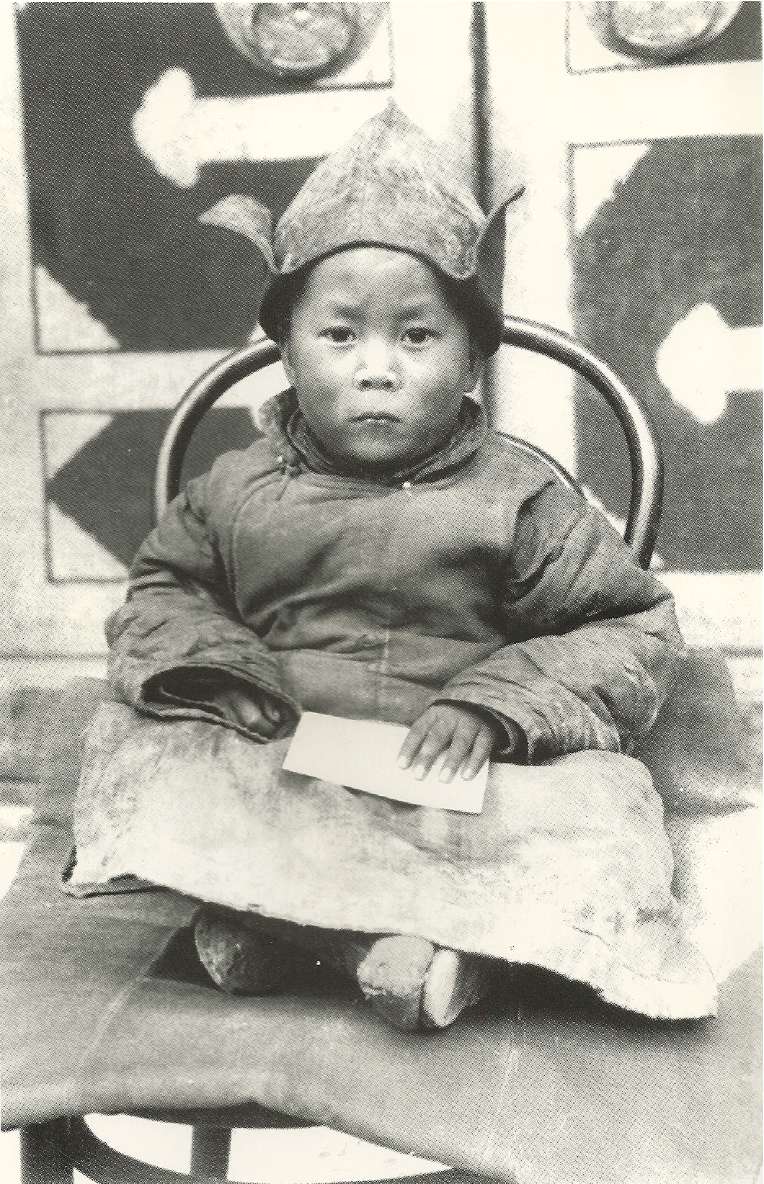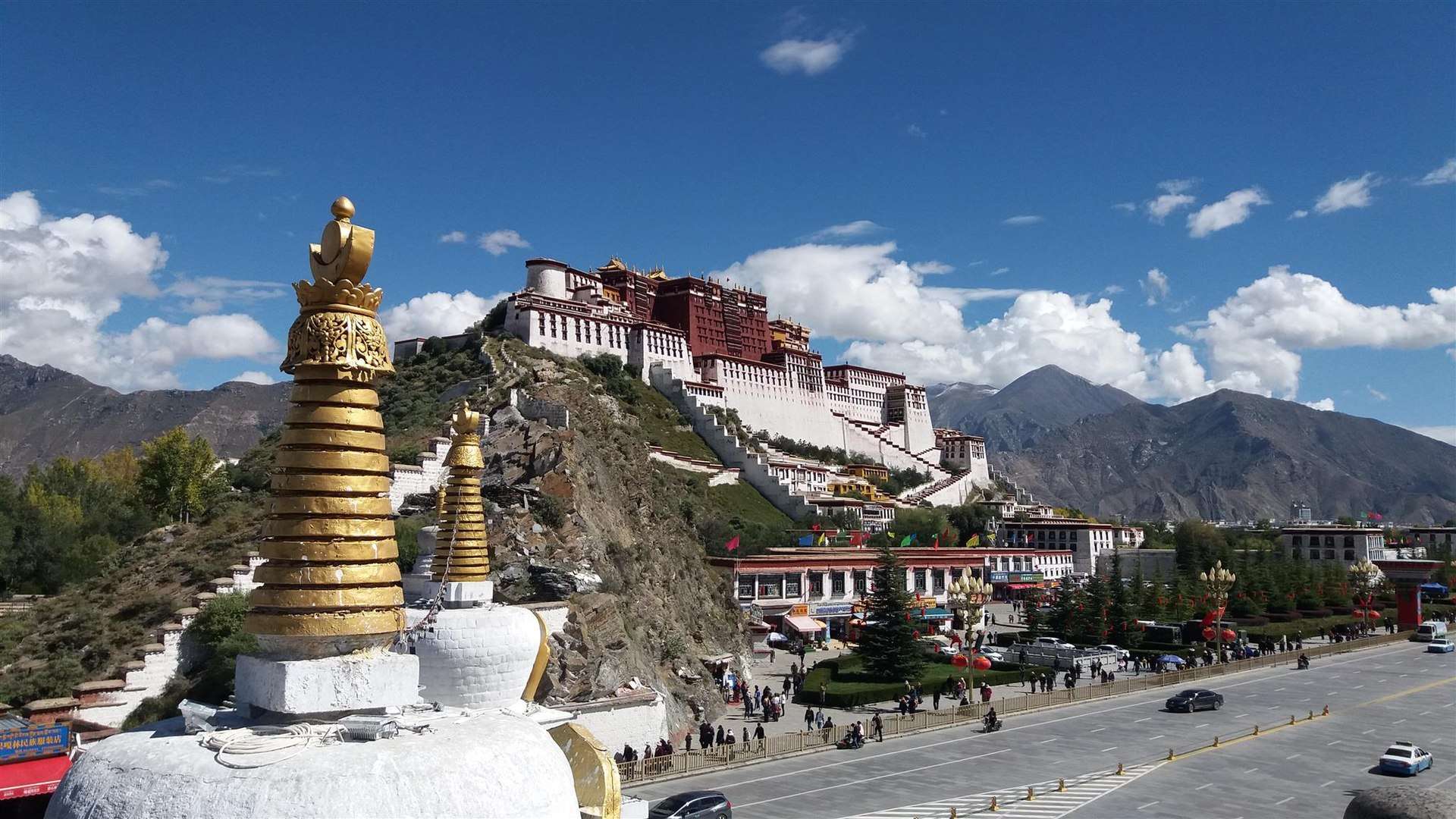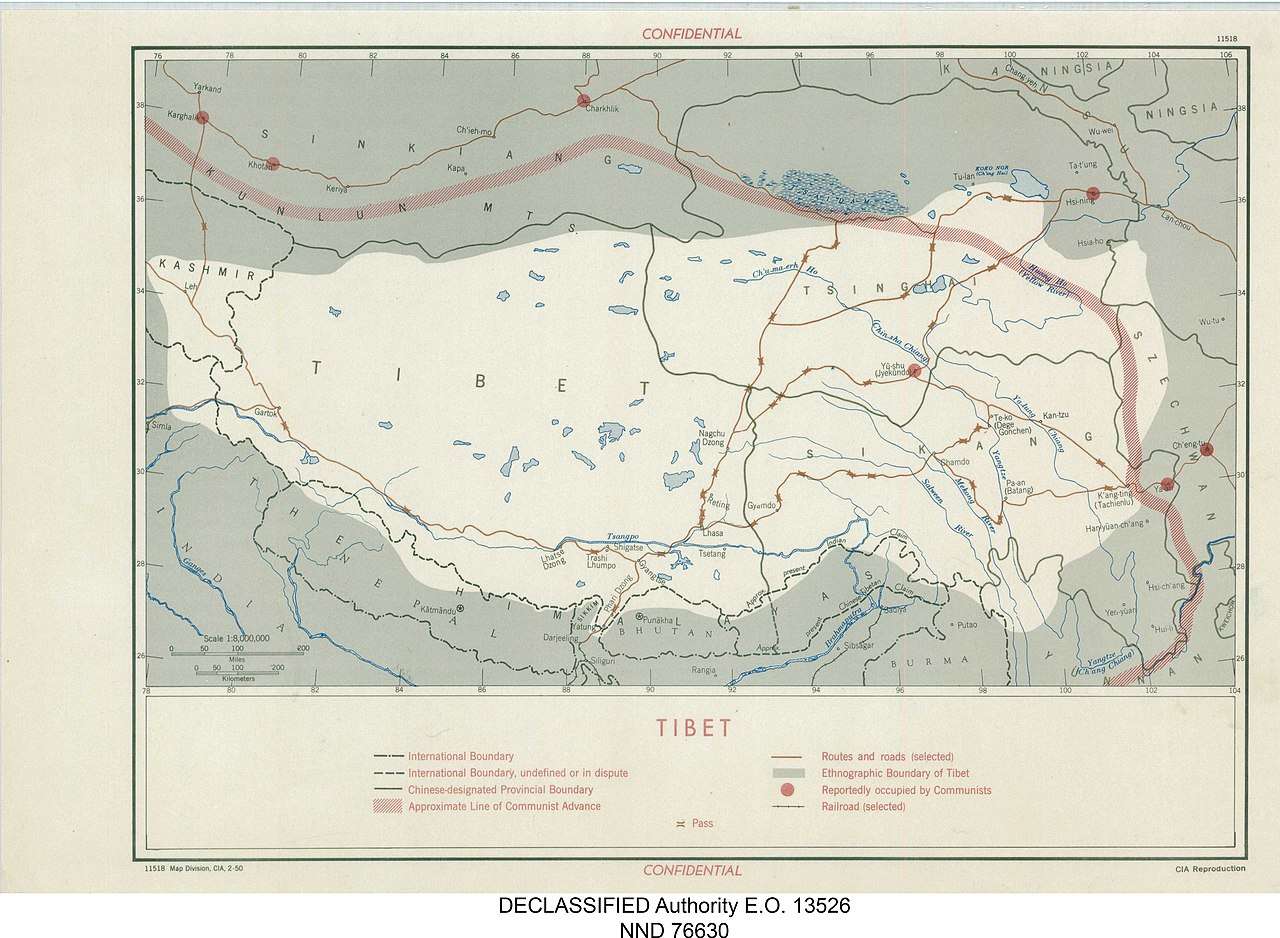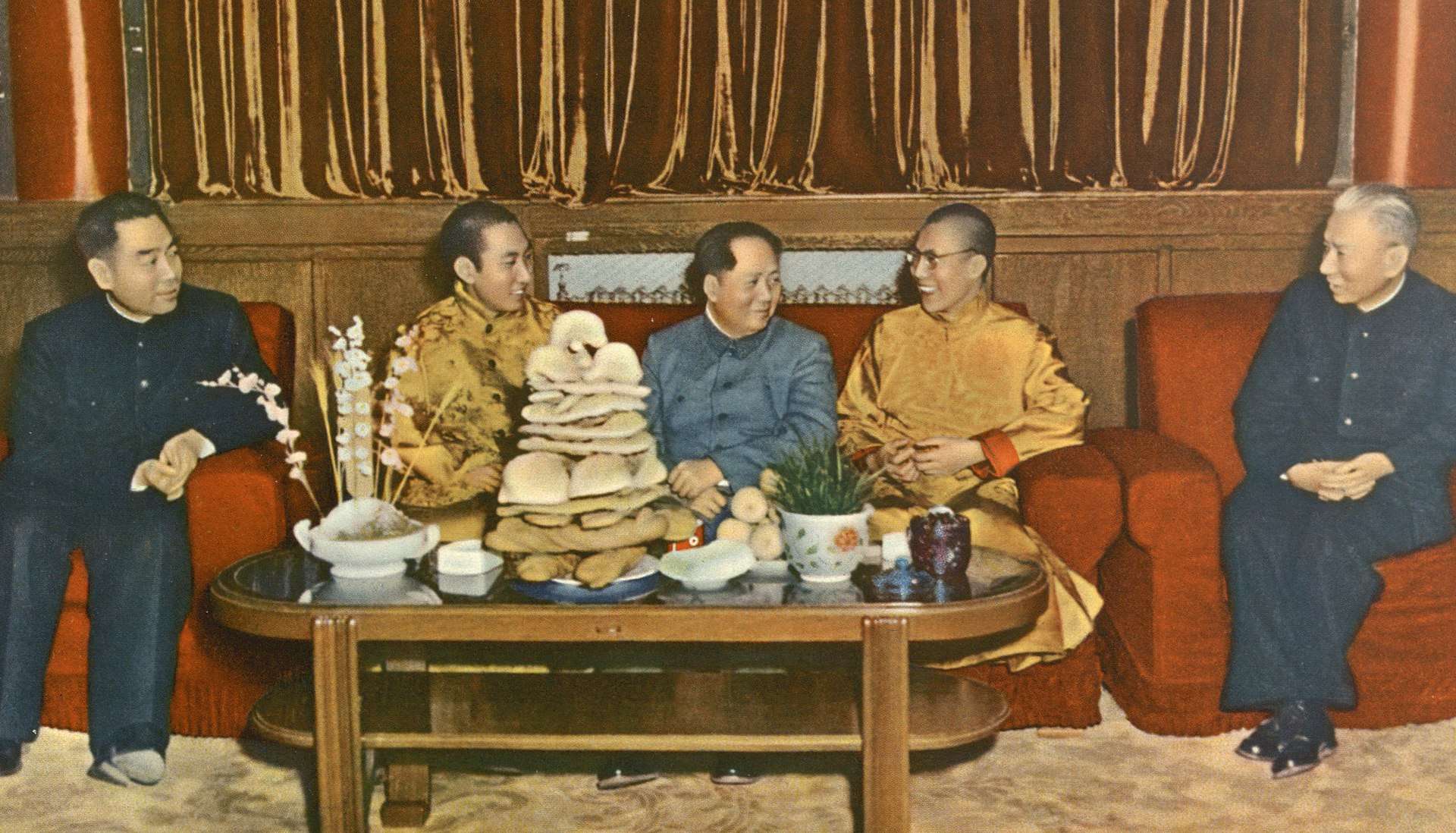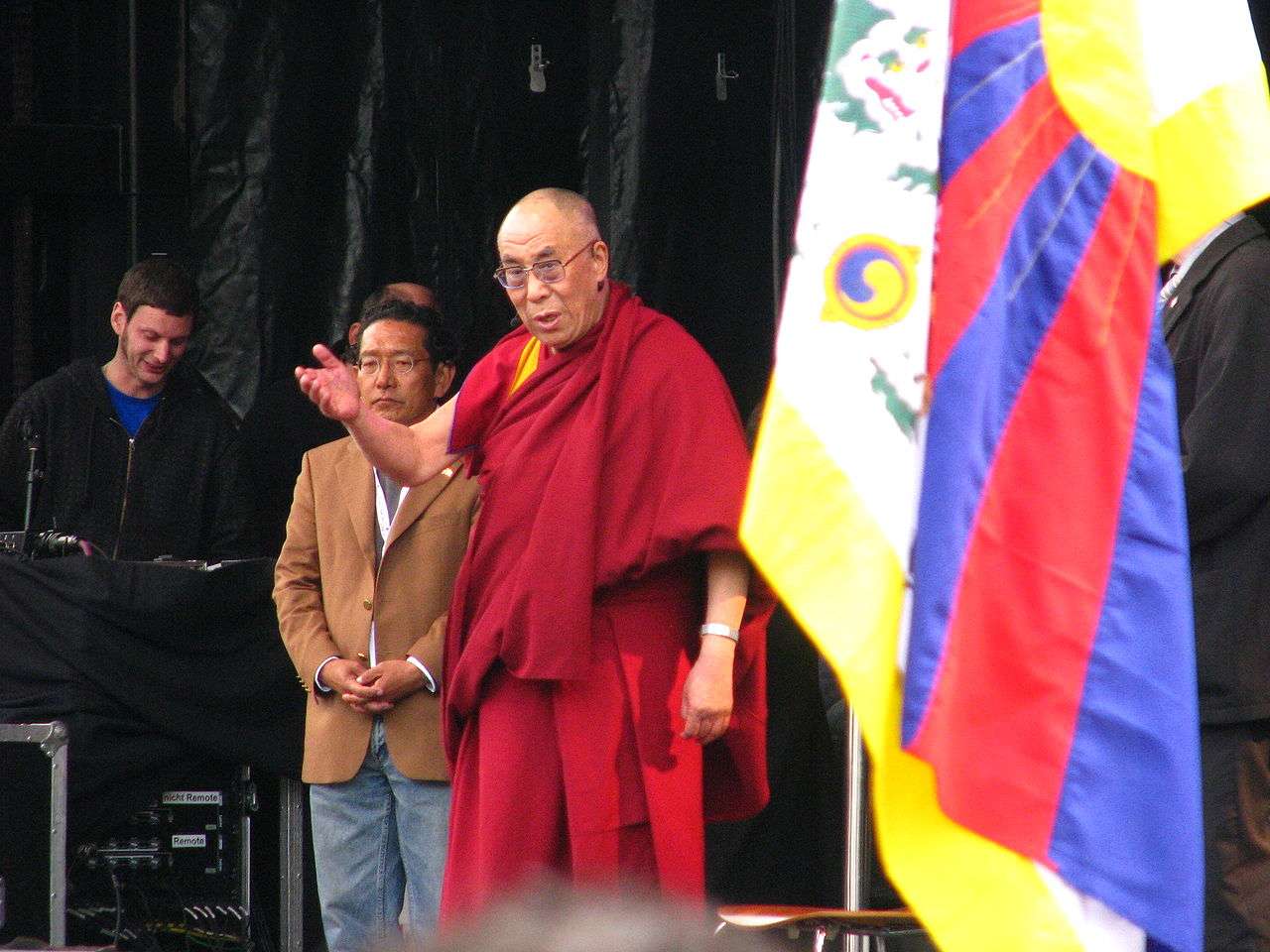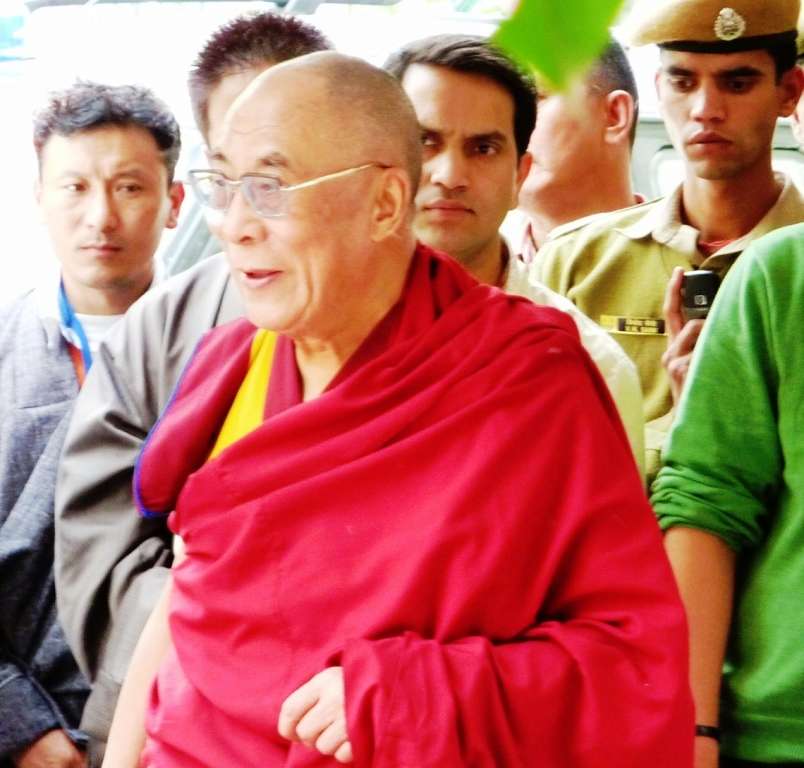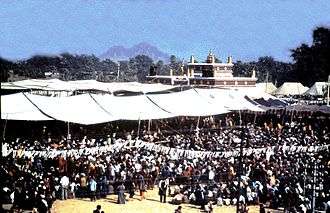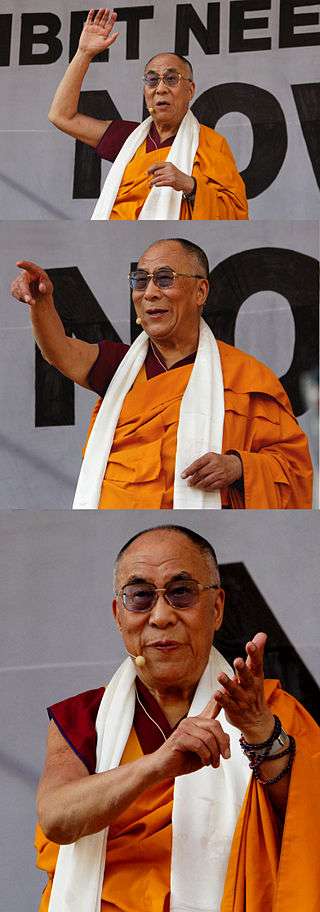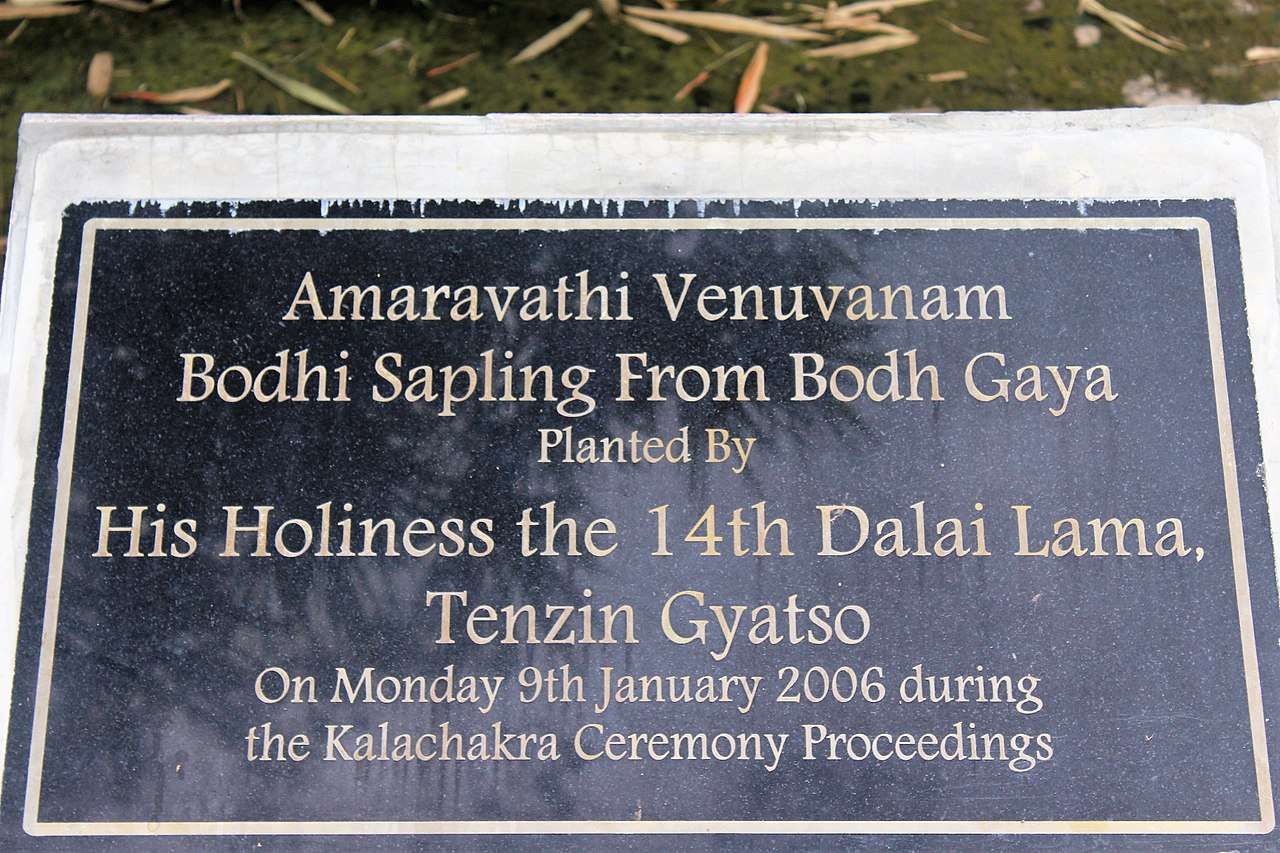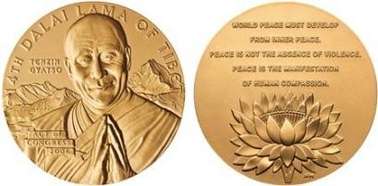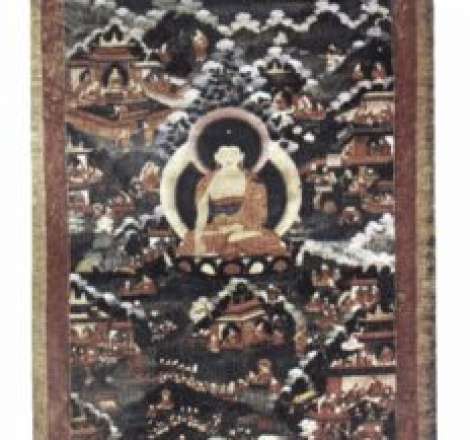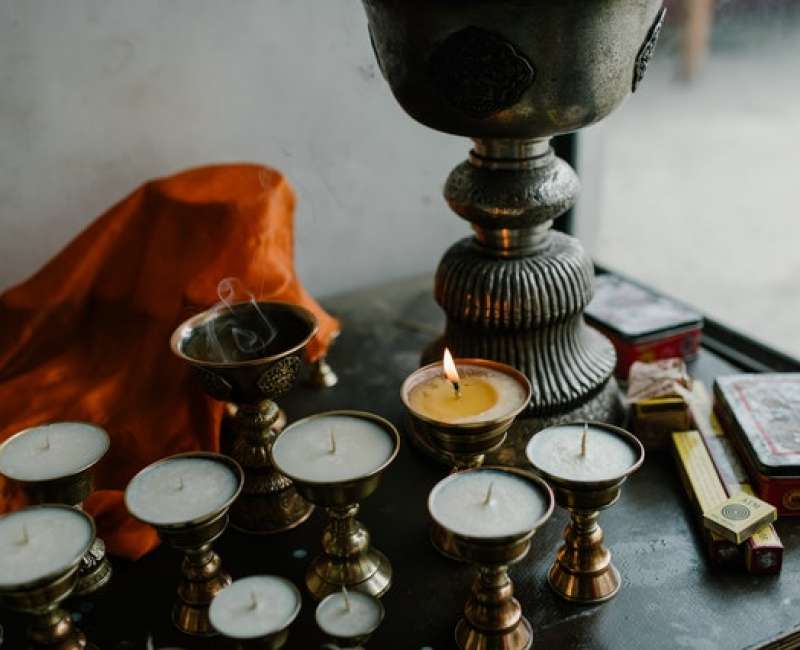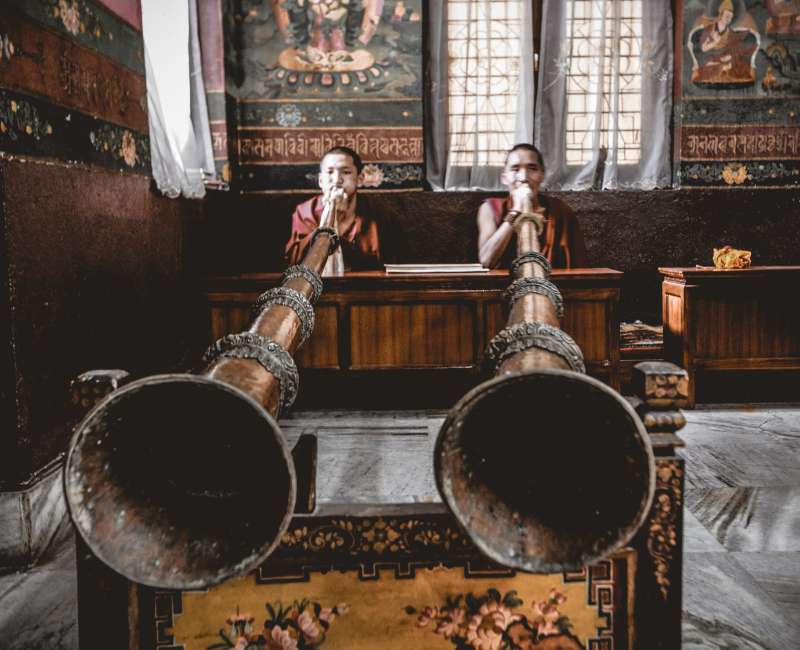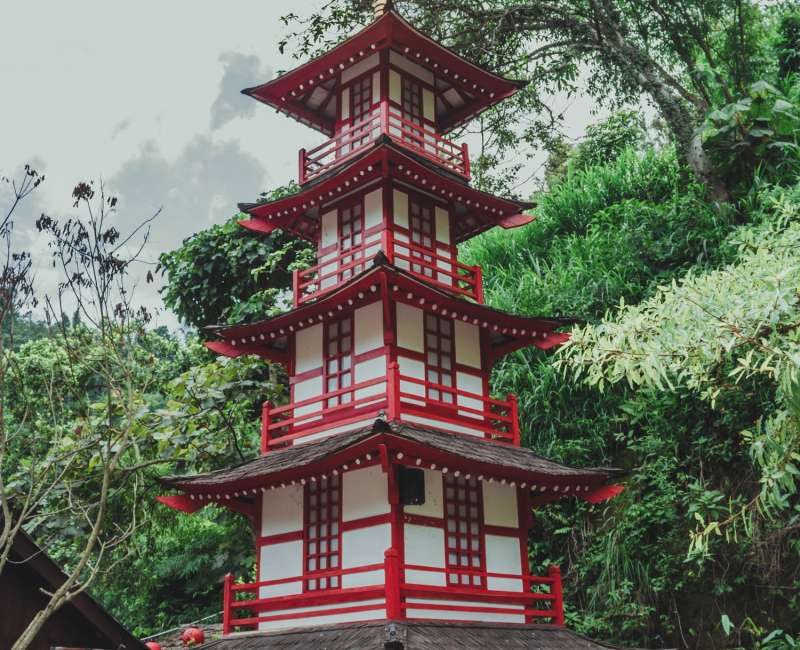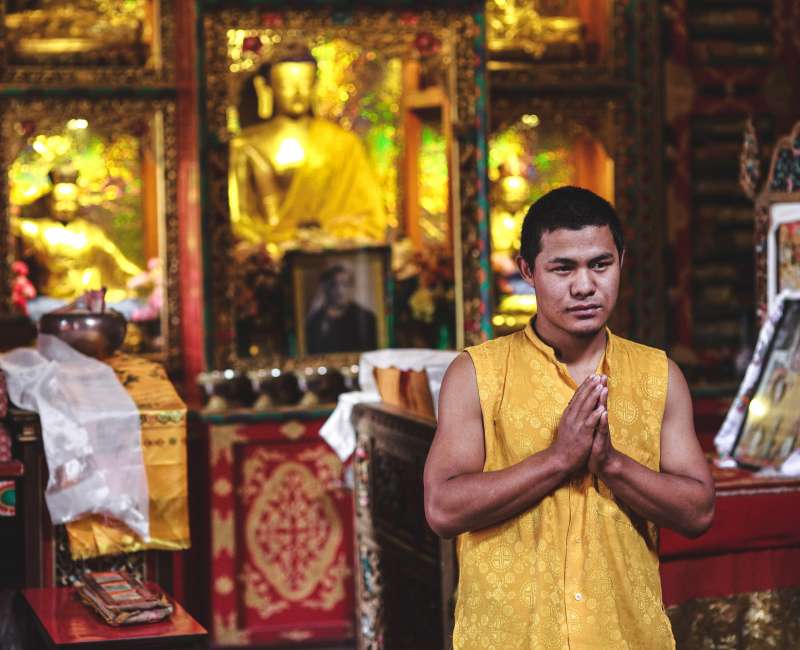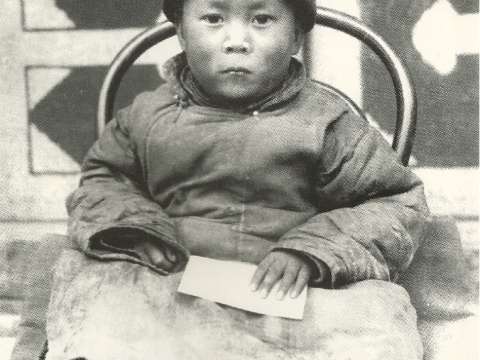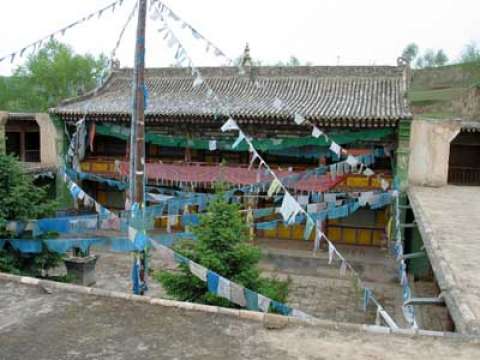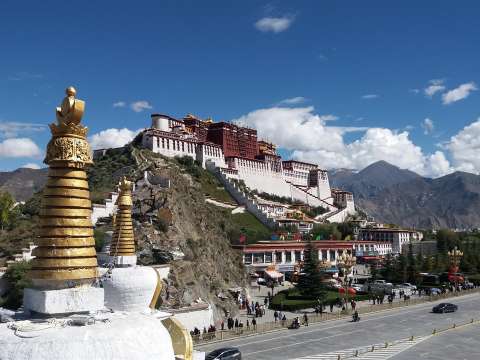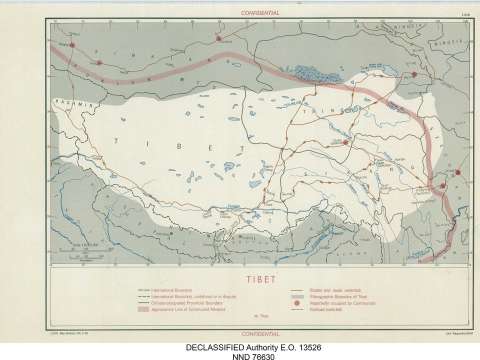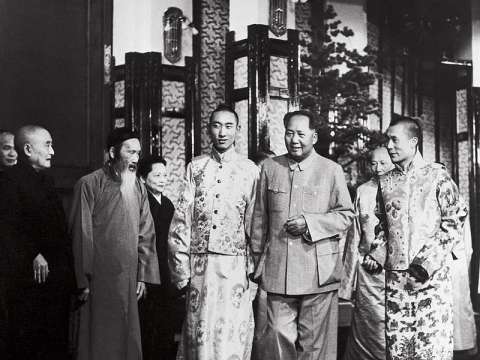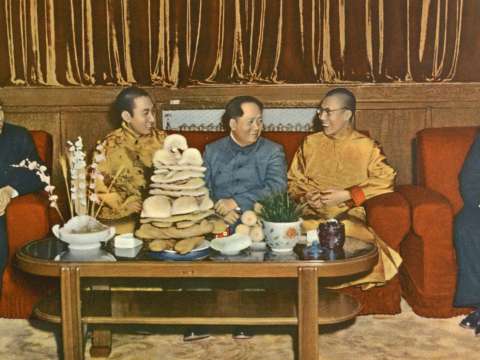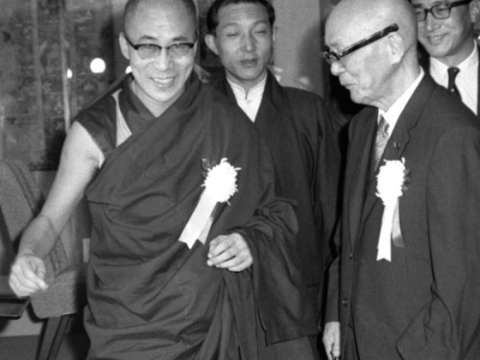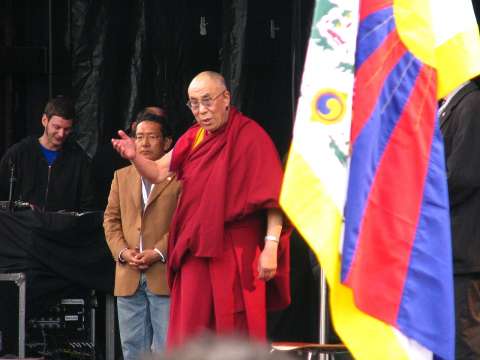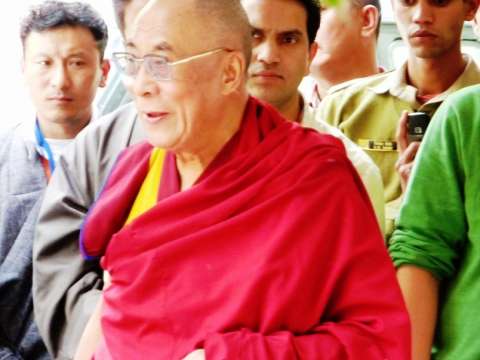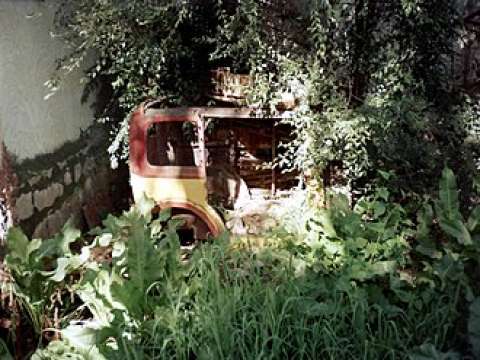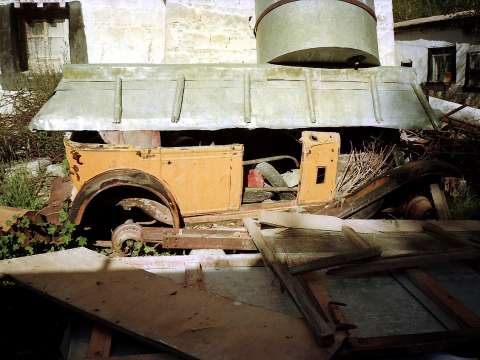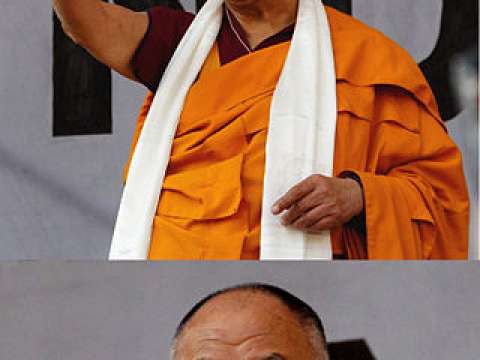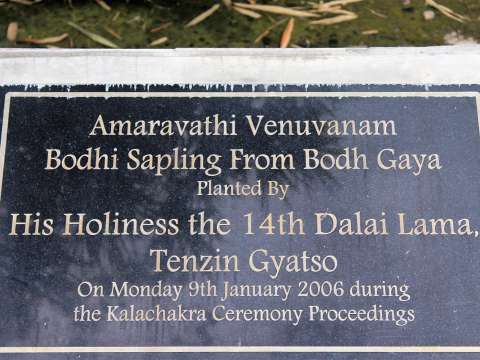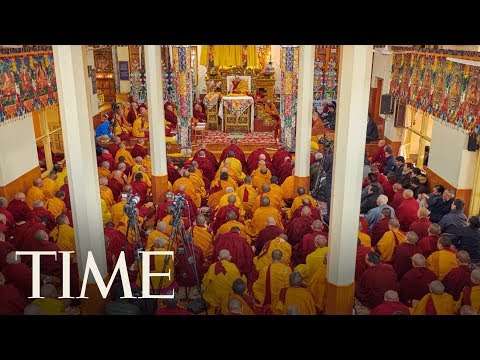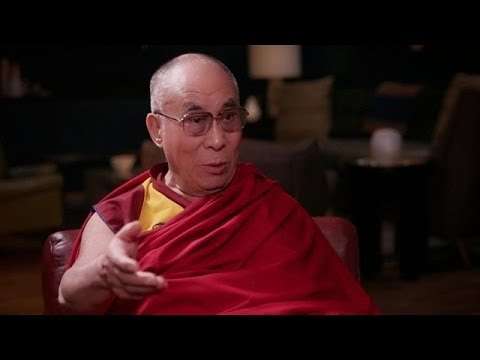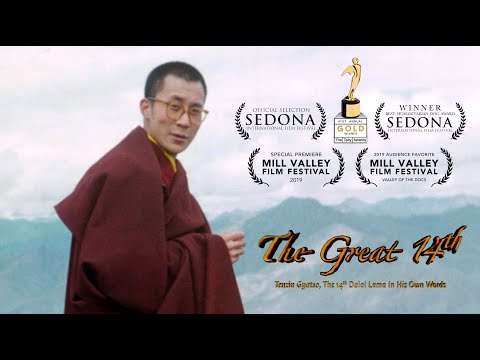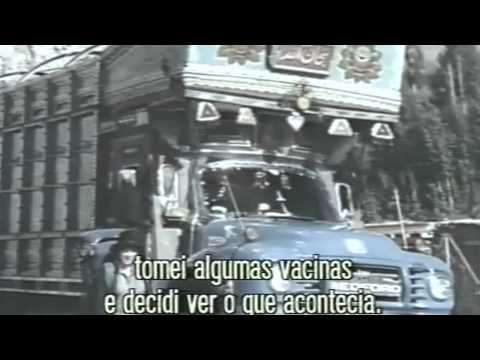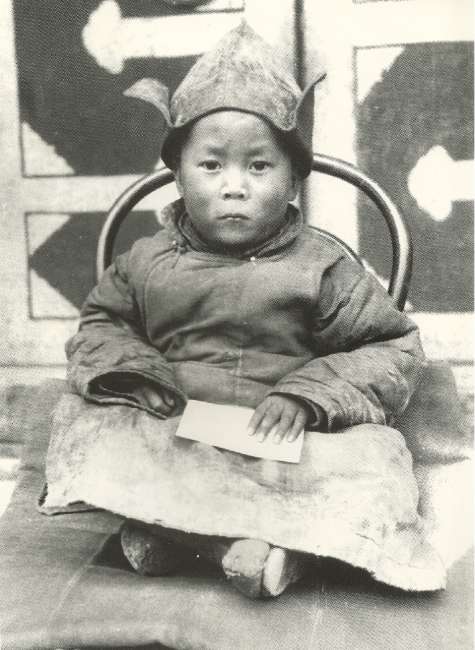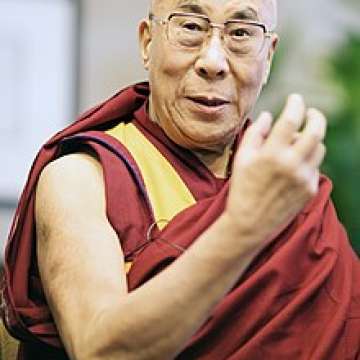

14th Dalai Lama
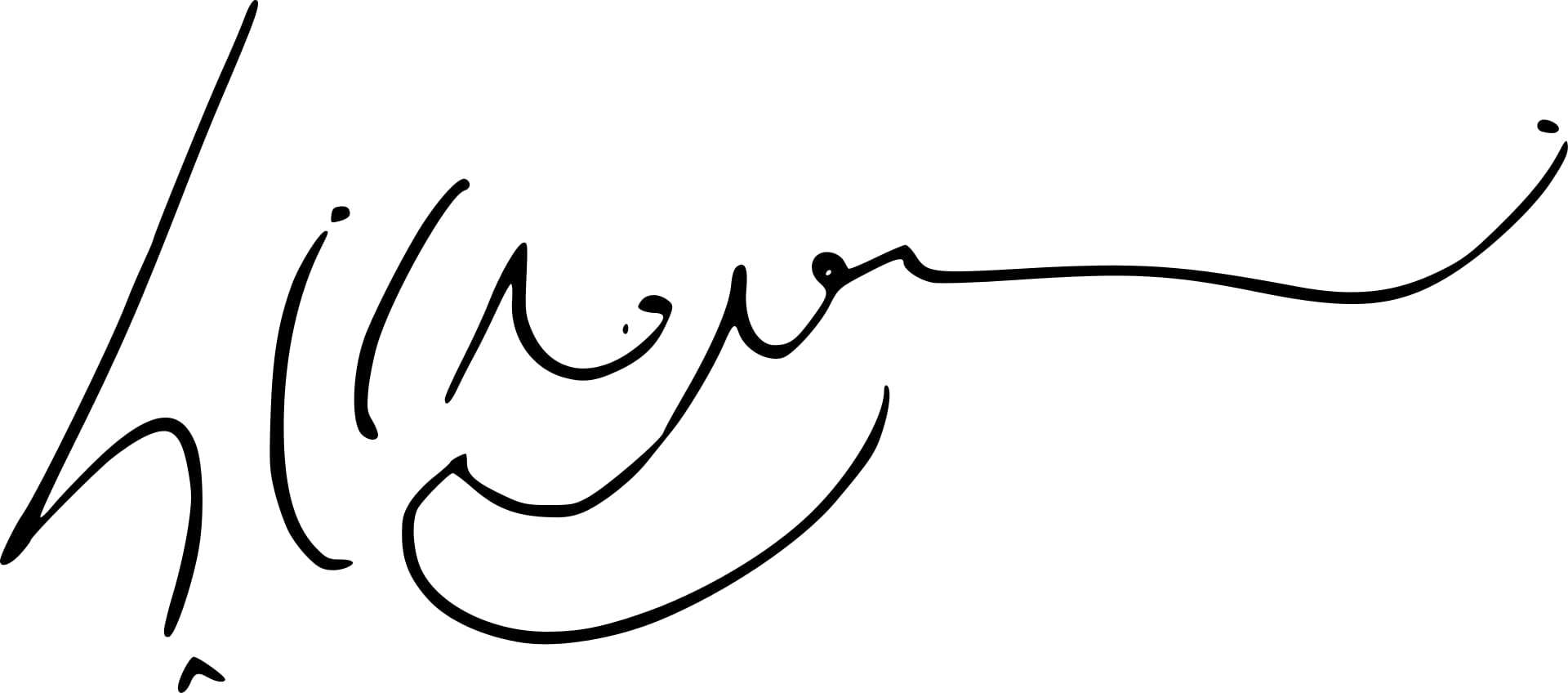
I believe each human being has the potential to change, to transform one’s own attitude, no matter how difficult the situation.
The 14th Dalai Lama (spiritual name Jetsun Jamphel Ngawang Lobsang Yeshe Tenzin Gyatso, known as Tenzin Gyatso; born Lhamo Dhondup), known as Gyalwa Rinpoche to the Tibetan people, is the current Dalai Lama, the highest spiritual leader of Tibet, and a retired political leader of Tibet. Born on 6 July 1935, or in the Tibetan calendar, in the Wood-Pig Year, 5th month, 5th day, he is considered a living Bodhisattva; specifically, an emanation of Avalokiteśvara. He is also the leader of the Gelug school, the newest and currently most dominant of the four major schools of Tibetan Buddhism, formally headed by the Ganden Tripa. The government of Tibet, the Ganden Phodrang, invested the Dalai Lama with temporal duties until his exile in 1959. On April 29, 1959, the Dalai Lama established the independent Tibetan government in exile in the north Indian hill station of Mussoorie, which then moved in May 1960 to Dharamshala, where he resides. He retired as political head in 2011 to make way for a democratic government.
The 14th Dalai Lama was born to a farming family, in Taktser Hongya in Chinese, in Amdo province Qinghai in Chinese, northeastern Tibet. He was selected as one of 3 reincarnated soul boys of the 13th Dalai Lama in 1937, but declared as the 14th Dalai Lama by Kashag on August 23, 1939 by ignoring the other two candidates before sitting-in-the-bed. As with the approval process for the 13th Dalai Lama, request to exempt Lhamo Thondup from lot-drawing process using Golden Urn to become the 14th Dalai Lama was approved by the Central Government on February 5th 1940. His sitting-in-the-bed ceremony as the Dalai Lama was held in Lhasa on 22 February 1940 and he eventually assumed full temporal political duties on 17 November 1950, at the age of 15, after the People's Republic of China's occupation of Tibet. The Tibetan government administered the historic Tibetan regions of Ü-Tsang, Kham and Amdo, and "In the course of Tibet's 2000-year history, the country came under a degree of foreign influence only for short periods of time in the thirteenth and eighteenth centuries."
During the 1959 Tibetan uprising, the Dalai Lama escaped to India, where he currently lives in exile while remaining the most important spiritual leader of Tibet. The Dalai Lama advocates for the welfare of Tibetans while continuing to call for the Middle Way Approach to negotiations with China for the autonomy of Tibet and the protection of Tibetan culture, including for the religious rights of Tibetans.
The Dalai Lama also meets with other world leaders, religious leaders, philosophers and scientists, and travels worldwide giving Tibetan Buddhist teachings. His work includes focus on the environment, economics, women's rights, nonviolence, interfaith dialogue, physics, astronomy, Buddhism and science, cognitive neuroscience, reproductive health and sexuality. Along with his teachings on Tibetan Mahayana and Vajrayana Buddhism, the Dalai Lama's Kalachakra teachings and initiations are international events. He is the chief Patron of the Maha Bodhi Society of India, conferred upon him at the 2008 Annual General Meeting of the Maha Bodhi Society of India. The Dalai Lama was awarded the Nobel Peace Prize in 1989, and the US Congressional Gold Medal in 2006. Time magazine named the Dalai Lama one of the "Children of Mahatma Gandhi" and Gandhi's spiritual heir to nonviolence.
Early life and background
Lhamo Thondup was born on 6 July 1935 to a farming and horse trading family in the small hamlet of Taktser, or Chija Tagtser Chinese: 红崖村; pinyin: Hóngyá Cūn; lit. 'Redcliff Village', at the edge of the traditional Tibetan region of Amdo in Qinghai Province. He was one of seven siblings to survive childhood, one of the three reincarnated Rinpoches in the same family. The eldest was his sister Tsering Dolma, eighteen years his senior. His eldest brother, Thupten Jigme Norbu, had been recognised at the age of three by the 13th Dalai Lama as the reincarnation of the high Lama, the 6th Taktser Rinpoche. His fifth brother, Tendzin Choegyal Chinese:达拉·洛桑三旦, had been recognised as the 16th Ngari Rinpoche. His sister, Jetsun Pema, spent most of her adult life on the Tibetan Children's Villages project. The Dalai Lama has said that his first language was "a broken Xining language which was a dialect of the Chinese language", a form of Central Plains Mandarin, and his family speak neither Amdo Tibetan nor Lhasa Tibetan.
After the demise of the 13th Dalai Lama, Reting Rinpoche and Langdun nephew of the 13th Dalai Lama became regent and vice regent of Tibet, this was approved by the Central Government, and in 1935, title “Zen Master of the Nation and Propagator of the Doctrine Chinese:辅国普化禅师” was conferred to Reting Rinpoche. In 1935, the Ordinance of Lama Temple Management Chinese: 管理喇嘛寺廟條例 was published by the Central Government. In 1936, the Method of Reincarnation of Lamas Chinese: 喇嘛轉世辦法 was published by the Mongolian and Tibetan Affairs Commission of the Central Government. Article 3 states that death of lamas including the Dalai Lama, the Panchen Lama should be reported to Mongolian and Tibetan Affairs Commission, soul boys should be found, reported to and checked by Mongolian and Tibetan Affairs Commission, lot-drawing ceremony with Golden Urn system should be held. Article 6 states that local governments should invite official from the Central Government to take care of the sitting-in-the-bed ceremony. Article 7 states that soul boys should not be searched from the current lama families. Article 7 echos what the Qianlong Emperor described in The Discourse of Lama to eliminate greedy family with multiple reincarnated rinpoches, lamas. Based on custom and regulation, regent was actively involved in the search for the reincarnation of the Dalai Lama. Following reported signs and visions, three search teams were sent out to the north-east, the east, and the south-east to locate the new incarnation when the boy who was to become the 14th Dalai Lama was about two years old. Sir Basil Gould, British delegate to Lhasa in 1936, related his account of the north-eastern team to Sir Charles Alfred Bell, former British resident in Lhasa and friend of the 13th Dalai Lama. Amongst other omens, the head of the embalmed body of the thirteenth Dalai Lama, at first facing south-east, had turned to face the north-east, indicating, it was interpreted, the direction in which his successor would be found. The Regent, Reting Rinpoche, shortly afterwards had a vision at the sacred lake of Lhamo La-tso which he interpreted as Amdo being the region to search. This vision was also interpreted to refer to a large monastery with a gilded roof and turquoise tiles, and a twisting path from it to a hill to the east, opposite which stood a small house with distinctive eaves. The team, led by Kewtsang Rinpoche, went first to meet the Panchen Lama, who had been stuck in Jyekundo, in northern Kham. The Panchen Lama had been investigating births of unusual children in the area ever since the death of the 13th Dalai Lama. He gave Kewtsang the names of three boys whom he had discovered and identified as candidates. Within a year the Panchen Lama had died. Two of his three candidates were crossed off the list but the third, a "fearless" child, the most promising, was from Taktser village, which, as in the vision, was on a hill, at the end of a trail leading to Taktser from the great Kumbum Monastery with its gilded, turquoise roof. There they found a house, as interpreted from the vision—the house where Lhamo Thondup lived.
The 14th Dalai Lama claims that at the time, the village of Taktser stood right on the "real border" between the region of Amdo and China. When the team visited, posing as pilgrims, its leader, a Sera Lama, pretended to be the servant and sat separately in the kitchen. He held an old mala that had belonged to the 13th Dalai Lama, and the boy Lhamo Dhondup, aged two, approached and asked for it. The monk said "if you know who I am, you can have it." The child said "Sera Lama, Sera Lama" and spoke with him in a Lhasa accent, in a dialect the boy's mother could not understand. The next time the party returned to the house, they revealed their real purpose and asked permission to subject the boy to certain tests. One test consisted of showing him various pairs of objects, one of which had belonged to the 13th Dalai Lama and one which had not. In every case, he chose the Dalai Lama's own objects and rejected the others.

From 1936 the Hui 'Ma Clique' Muslim warlord Ma Bufang ruled Qinghai as its governor under the nominal authority of the Republic of China central government. According to an interview with the 14th Dalai Lama, in the 1930s, Ma Bufang had seized this north-east corner of Amdo in the name of Chiang Kai-shek's weak government and incorporated it into the Chinese province of Qinghai. Before going to Taktser, Kewtsang had gone to Ma Bufang to pay his respects. When Ma Bufang heard a candidate had been found in Taktser, he had the family brought to him in Xining. He first demanded proof that the boy was the Dalai Lama, but the Lhasa government, though informed by Kewtsang that this was the one, told Kewtsang to say he had to go to Lhasa for further tests with other candidates. They knew that if he was declared to be the Dalai Lama, the Chinese government would insist on sending a large army escort with him, which would then stay in Lhasa and refuse to budge. Ma Bufang, together with Kumbum Monastery, then refused to allow him to depart unless he was declared to be the Dalai Lama, but withdrew this demand in return for 100,000 Chinese dollars ransom in silver to be shared amongst them, to let them go to Lhasa. Kewtsang managed to raise this, but the family was only allowed to move from Xining to Kumbum when a further demand was made for another 330,000 dollars ransom: one hundred thousand each for government officials, the commander-in-chief, and the Kumbum Monastery; twenty thousand for the escort; and only ten thousand for Ma Bufang himself, he said.
Two years of diplomatic wrangling followed before it was accepted by Lhasa that the ransom had to be paid to avoid the Chinese getting involved and escorting him to Lhasa with a large army. Meanwhile, the boy was kept at Kumbum where two of his brothers were already studying as monks and recognised incarnate lamas. The payment of 300,000 silver dollars was then advanced by Muslim traders en route to Mecca in a large caravan via Lhasa. They paid Ma Bufang on behalf of the Tibetan government against promissory notes to be redeemed, with interest, in Lhasa. The 20,000-dollar fee for an escort was dropped, since the Muslim merchants invited them to join their caravan for protection; Ma Bufang sent 20 of his soldiers with them and was paid from both sides since the Chinese government granted him another 50,000 dollars for the expenses of the journey. Furthermore, the Indian government helped the Tibetans raise the ransom funds by affording them import concessions.
On 22 September 1938, representatives of Tibet Office in Beijing informed Mongolian and Tibetan Affairs Commission that 3 candidates were found and ceremony of Golden Urn would be held in Tibet.

In October 1938, the Method of Using Golden Urn for the 14th Dalai Lama Chinese: 十四世达赖喇嘛转世掣签征认办法 was drafted by Mongolian and Tibetan Affairs Commission.
On 12 December 1938, regent Reting Rinpoche informed Mongolian and Tibetan Affairs Commission that 3 candidates were found and ceremony of Golden Urn would be held.
Vice Regent Langdun actively supported son of his relative to be the 14th Dalai Lama. From the perspective of the regent Reting Rinpoche, the selection of the Qinghai soul boy was mainly due to his merits. Therefore, he hoped that the Qinghai soul boy could be selected as the reincarnation of the 14th Dalai Lama. In April 1939, Vice Regent Langdun was forced to resign.
Released from Kumbum, on 21 July 1939 the party travelled across Tibet on a journey to Lhasa in the large Muslim caravan with Lhamo Thondup, now 4 years old, riding with his brother Lobsang in a special palanquin carried by two mules, two years after being discovered. As soon as they were out of Ma Bufang's area, he was declared to be the 14th Dalai Lama by Kashag on 23 August by ignoring the other 2 candidates.
On 17 September 1939, the Regent Reting Rinpoche told Wu Zhongxin that all procedures would follow based on Wu Zhongxin's advice when Wu Zhongxin arrived Tibet. Lhamo Thondup arrived in Lhasa on 8 October 1939.
On 23 November 1939, haircut ceremony, naming ceremony of monastic name of Tenzin Gyatso were performed without Wu's presence.
On January 26, 1940, the Regent Reting Rinpoche requested the Central Government to exempt Lhamo Dhondup from lot-drawing process using Golden Urn to become the 14th Dalai Lama.
One January 31st 1940, Wu Zhongxin inspected Lhamo Thondup.
On February 5th 1940, request to exempt Lhamo Thondup from lot-drawing process to become the 14th Dalai Lama was approved by the Central Government
400 thousand yuans were allocated by the Central Government for the sitting-in-the-bed ceremony which was handled by Reting Rinpoche, and presided by Wu Zhongxin based on the custom and religious rituals of the Qing Dynasty. Reting Rinpoche was forced indirectly to resign in 1941, decision was sent to Central Government, in February 1941, the 3rd Taktra Rinpoche informed the Central Government he would continue the work as Regent of Tibet. Both Choekyong Tsering father of Lhamo Dhondup and Reting Rinponche were poisoned and died in 1947. Since Golden Urn was not used for the selection of the 14th Dalai Lama, there was rumor that a child of relative of the 13th Dalai Lama was the real 14th Dalai Lama. Lot-drawing process ceremony was ordered to be held between that child and Lhamo Dhondup. There was very limited Chinese involvement at this time.
Tibetan Buddhists normally refer to him as Yishin Norbu Wish-Fulfilling Gem, Kyabgon Saviour, or just Kundun Presence. His devotees, as well as much of the Western world, often call him His Holiness the Dalai Lama, the style employed on the Dalai Lama's website. According to the Dalai Lama, he had a succession of tutors in Tibet including Reting Rinpoche, Tathag Rinpoche, Ling Rinpoche and lastly Trijang Rinpoche, who became junior tutor when he was nineteen. At the age of 11 he met the Austrian mountaineer Heinrich Harrer, who became his videographer and tutor about the world outside Lhasa. The two remained friends until Harrer's death in 2006.
In 1959, at the age of 23, he took his final examination at Lhasa's Jokhang Temple during the annual Monlam or Prayer Festival. He passed with honours and was awarded the Lharampa degree, the highest-level geshe degree, roughly equivalent to a doctorate in Buddhist philosophy.
Life as the Dalai Lama
Historically the Dalai Lamas or their regents held political and religious leadership over Tibet from Lhasa with varying degrees of influence depending on the regions of Tibet and periods of history. This began with the 5th Dalai Lama's rule in 1642 and lasted until the 1950s except for 1705–1750, during which period the Dalai Lamas headed the Tibetan government or Ganden Phodrang. Until 1912 however, when the 13th Dalai Lama declared the complete independence of Tibet, their rule was generally subject to patronage and protection of firstly Mongol kings 1642–1720 and then the Manchu-led Qing dynasty 1720–1912.
During the Dalai Lama's recognition process, the cultural Anthropologist Goldstein writes that "it seems inconceivable that they Tibetan government would ask China's permission to dispense with the Chinese-instituted Golden Urn selection process that had in fact already been ignored in the selection of the 13th Dalai Lama". In 1877, request to exempt Lobu Zangtab Kaijia Mucuo Chinese: 罗布藏塔布开甲木措 from using lot-drawing process to become the 13th Dalai Lama was approved by the Central Government.

Afterwards in 1939, at the age of four, the Dalai Lama was taken in a procession of lamas to Lhasa. The traditional sitting-in-the-bed ceremony enthroning the 14th Dalai Lama was attended by observing foreign dignitaries after a traditional Tibetan recognition processes. Sir Basil Gould, the British representative of the Government of India, has left a highly detailed account of the ceremonies surrounding the enthronement of the 14th Dalai Lama in Chapter 16 of his memoir, The Jewel in the Lotus. Despite historical records of eyewitness accounts, China's Kuomintang government later presented false claims to have ratified the Dalai Lama, and that a Kuomintang representative, General Wu Zhongxin, presided over the ceremony.
The British representative Sir Basil Gould, who was also at the enthronement ceremony, disputes the Chinese claim to have presided over it. He criticised the Chinese account as follows:
The report was issued in the Chinese Press that Mr Wu had escorted the Dalai Lama to his throne and announced his installation, that the Dalai Lama had returned thanks, and prostrated himself in token of his gratitude. Every one of these Chinese claims was false. Mr Wu was merely a passive spectator. He did no more than present a ceremonial scarf, as was done by the others, including the British Representative. But the Chinese have the ear of the world, and can later refer to their press records and present an account of historical events that is wholly untrue. Tibet has no newspapers, either in English or Tibetan, and has therefore no means of exposing these falsehoods.
Tibetan scholar Nyima Gyaincain wrote that based on Tibetan tradition, there was no such thing as presiding over an event, and wrote that the word "主持 preside or organize" was used in many places in communication documents. The meaning of the word was different than what we understand today. He added that Wu Zhongxin spent a lot of time and energy on the event, his effect of presiding over or organizing the event was very obvious.
After his enthronement, the Dalai Lama's childhood was then spent between the Potala Palace and Norbulingka, his summer residence, both of which are now UNESCO World Heritage sites.

Chiang Kai Shek ordered Ma Bufang to put his Muslim soldiers on alert for an invasion of Tibet in 1942. Ma Bufang complied, and moved several thousand troops to the border with Tibet. Chiang also threatened the Tibetans with aerial bombardment if they worked with the Japanese. Ma Bufang attacked the Tibetan Buddhist Tsang monastery in 1941. He also constantly attacked the Labrang monastery.
In October 1950 the army of the People's Republic of China marched to the edge of the Dalai Lama's territory and sent a delegation after defeating a legion of the Tibetan army in warlord-controlled Kham. On 17 November 1950, at the age of 15, the 14th Dalai Lama assumed full temporal political power as ruler of Tibet.
Cooperation and conflicts with the People's Republic of China
The Panchen Lama and Dalai Lama had many conflicts throughout Tibetan history. Dalai Lama's formal rule was brief. He sent a delegation to Beijing, which signed the Seventeen Point Agreement for the Peaceful Liberation of Tibet on 23 May 1951. The 14th Dalai Lama ratified the agreement on 24 October 1951. He worked with the Chinese government: in September 1954, together with the 10th Panchen Lama he went to the Chinese capital to meet Mao Zedong and attend the first session of the National People's Congress as a delegate, primarily discussing China's constitution. On 27 September 1954, the Dalai Lama was selected as a Vice chairman of the Standing Committee of the National People's Congress.
The United States informed the Dalai Lama in 1951 that in order to receive assistance and support from the United States, he must depart from Tibet and publicly disavow "agreements concluded under duress" between the representatives of Tibet and China. The United States also informed the Dalai Lama in 1951 to approach India informally to obtain clarification of the attitude of his departure from Tibet and related problems, it's the understanding of the United States that the Indian Government would be prepared to permit him to pass through or to reside in India.
In 1956, on a trip to India to celebrate the Buddha's Birthday, the Dalai Lama asked the Prime Minister of India, Jawaharlal Nehru, if he would allow him political asylum should he choose to stay. Nehru discouraged this as a provocation against peace, and reminded him of the Indian Government's non-interventionist stance agreed upon with its 1954 treaty with China.

On 18 April 1959, the 14th Dalai Lama issued statement that the agreement was made under pressure of the Chinese Government. He would later claim that the delegation signed agreement without his authorization.
In 1964, decision of the State Council of China on revocation of duties of the Dalai Lama Tenzin Gyatso was made and published.
Long called a "splitist" and "traitor" by China, the Dalai Lama has attempted formal talks over Tibet's status in China. In 2019, after the United States passed a law requiring the US to deny visas to Chinese officials in charge of implementing policies that restrict foreign access to Tibet, the US Ambassador to China "encouraged the Chinese government to engage in substantive dialogue with the Dalai Lama or his representatives, without preconditions, to seek a settlement that resolves differences".

The Chinese Foreign Ministry has warned the US and other countries to "shun" the Dalai Lama during visits and often uses trade negotiations and human rights talks as an incentive to do so. China sporadically bans images of the Dalai Lama and arrests citizens for owning photos of him in Tibet. Tibet Autonomous Region government job candidates must strongly denounce the Dalai Lama, as announced on the Tibet Autonomous Region government's online education platform, "Support the Communist Party’s leadership, resolutely implement the Party’s line, line of approach, policies, and the guiding ideology of Tibet work in the new era; align ideologically, politically, and in action with the Party Central Committee; oppose any splittist tendencies; expose and criticize the Dalai Lama; safeguard the unity of the motherland and ethnic unity and take a firm stand on political issues, taking a clear and distinct stand".
The Dalai Lama is a target of Chinese state sponsored hacking. Security experts claim "targeting Tibetan activists is a strong indicator of official Chinese government involvement" since economic information is the primary goal of private Chinese hackers. In 2009 the personal office of the Dalai Lama asked researchers at the Munk Center for International Studies at the University of Toronto to check its computers for malicious software. This led to uncovering GhostNet, a large-scale cyber spying operation which infiltrated at least 1,295 computers in 103 countries, including embassies, foreign ministries, other government offices, and organizations affiliated with the Dalai Lama in India, Brussels, London and New York, and believed to be focusing on the governments of South and Southeast Asia. A second cyberspy network, Shadow Network, was discovered by the same researchers in 2010. Stolen documents included a years worth of the Dalai Lama's personal email, and classified government material relating to Indian, West Africa, the Russian Federation, the Middle East, and NATO. "Sophisticated" hackers were linked to universities in China, Beijing again denied involvement. Chinese hackers posing as The New York Times, Amnesty International and other organization's reporters targeted the private office of the Dalai Lama, Tibetan Parliament members, and Tibetan nongovernmental organizations, among others, in 2019.
Exile to India
At the outset of the 1959 Tibetan uprising, fearing for his life, the Dalai Lama and his retinue fled Tibet with the help of the CIA's Special Activities Division, crossing into India on 30 March 1959, reaching Tezpur in Assam on 18 April. Some time later he set up the Government of Tibet in Exile in Dharamshala, India, which is often referred to as "Little Lhasa". After the founding of the government in exile he re-established the approximately 80,000 Tibetan refugees who followed him into exile in agricultural settlements. He created a Tibetan educational system in order to teach the Tibetan children the language, history, religion, and culture. The Tibetan Institute of Performing Arts was established in 1959 and the Central Institute of Higher Tibetan Studies became the primary university for Tibetans in India in 1967. He supported the refounding of 200 monasteries and nunneries in an attempt to preserve Tibetan Buddhist teachings and the Tibetan way of life.

The Dalai Lama appealed to the United Nations on the rights of Tibetans. This appeal resulted in three resolutions adopted by the General Assembly in 1959, 1961, and 1965, all before the People's Republic was allowed representation at the United Nations. The resolutions called on China to respect the human rights of Tibetans. In 1963, he promulgated a democratic constitution which is based upon the Universal Declaration of Human Rights, creating an elected parliament and an administration to champion his cause. In 1970, he opened the Library of Tibetan Works and Archives in Dharamshala which houses over 80,000 manuscripts and important knowledge resources related to Tibetan history, politics and culture. It is considered one of the most important institutions for Tibetology in the world.
In 2016, there were demands from Indian citizens and politicians of different political parties to confer the Dalai Lama the prestigious Bharat Ratna, the highest civilian honour of India, which has only been awarded to a non-Indian citizen twice in its history.
In 2021, it was revealed that the Dalai Lama’s inner circle were listed in the Pegasus project data.
International advocacy
At the Congressional Human Rights Caucus in 1987 in Washington, D.C., the Dalai Lama gave a speech outlining his ideas for the future status of Tibet. The plan called for Tibet to become a democratic "zone of peace" without nuclear weapons, and with support for human rights. The Dalai Lama has indicated that he wishes to return to Tibet only if the People's Republic of China agrees not to make any precondition for his return. In the 1970s, the Paramount leader Deng Xiaoping set China's sole return requirement to the Dalai Lama as that he "must as a Chinese citizen ... that is, patriotism".
The Dalai Lama celebrated his seventieth birthday on 6 July 2005. About 10,000 Tibetan refugees, monks and foreign tourists gathered outside his home. Patriarch Alexius II of the Russian Orthodox Church alleged positive relations with Buddhists. However, later that year, the Russian state prevented the Dalai Lama from fulfilling an invitation to the traditionally Buddhist republic of Kalmykia. The President of the Republic of China Taiwan, Chen Shui-bian, attended an evening celebrating the Dalai Lama's birthday at the Chiang Kai-shek Memorial Hall in Taipei. In October 2008 in Japan, the Dalai Lama addressed the 2008 Tibetan violence that had erupted and that the Chinese government accused him of fomenting. He responded that he had "lost faith" in efforts to negotiate with the Chinese government, and that it was "up to the Tibetan people" to decide what to do.

Thirty Taiwanese indigenous peoples protested against the Dalai Lama during his visit to Taiwan after Typhoon Morakot and denounced it as politically motivated.
The Dalai Lama is an advocate for a world free of nuclear weapons, and currently serves on the Advisory Council of the Nuclear Age Peace Foundation.
The Dalai Lama has voiced his support for the Campaign for the Establishment of a United Nations Parliamentary Assembly, an organisation which campaigns for democratic reformation of the United Nations, and the creation of a more accountable international political system.
Teaching activities, public talks
Despite becoming 80 years old in 2015, he maintains a busy international lecture and teaching schedule. His public talks and teachings are usually webcast live in multiple languages, via an inviting organisation's website, or on the Dalai Lama's own website. Scores of his past teaching videos can be viewed there, as well as public talks, conferences, interviews, dialogues and panel discussions.
The Dalai Lama's best known teaching subject is the Kalachakra tantra which, as of 2014, he had conferred a total of 33 times, most often in India's upper Himalayan regions but also in the Western world. The Kalachakra Wheel of Time is one of the most complex teachings of Buddhism, sometimes taking two weeks to confer, and he often confers it on very large audiences, up to 200,000 students and disciples at a time.
The Dalai Lama is the author of numerous books on Buddhism, many of them on general Buddhist subjects but also including books on particular topics like Dzogchen, a Nyingma practice.

In his essay "The Ethic of Compassion" 1999, the Dalai Lama expresses his belief that if we only reserve compassion for those that we love, we are ignoring the responsibility of sharing these characteristics of respect and empathy with those we do not have relationships with, which cannot allow us to "cultivate love." He elaborates upon this idea by writing that although it takes time to develop a higher level of compassion, eventually we will recognize that the quality of empathy will become a part of life and promote our quality as humans and inner strength.
He frequently accepts requests from students to visit various countries worldwide in order to give teachings to large Buddhist audiences, teachings that are usually based on classical Buddhist texts and commentaries, and most often those written by the 17 pandits or great masters of the Nalanda tradition, such as Nagarjuna, Kamalashila, Shantideva, Atisha, Ayradeva and so on.
The Dalai Lama refers to himself as a follower of these Nalanda masters, in fact he often asserts that 'Tibetan Buddhism' is based on the Buddhist tradition of Nalanda monastery in ancient India, since the texts written by those 17 Nalanda pandits or masters, to whom he has composed a poem of invocation, were brought to Tibet and translated into Tibetan when Buddhism was first established there and have remained central to the teachings of Tibetan Buddhism ever since.

As examples of other teachings, in London in 1984 he was invited to give teachings on the Twelve Links of Dependent Arising, and on Dzogchen, which he gave at Camden Town Hall; in 1988 he was in London once more to give a series of lectures on Tibetan Buddhism in general, called 'A Survey of the Paths of Tibetan Buddhism'. Again in London in 1996 he taught the Four Noble Truths, the basis and foundation of Buddhism accepted by all Buddhists, at the combined invitation of 27 different Buddhist organisations of all schools and traditions belonging to the Network of Buddhist Organisations UK.
In India, the Dalai Lama gives religious teachings and talks in Dharamsala and numerous other locations including the monasteries in the Tibetan refugee settlements, in response to specific requests from Tibetan monastic institutions, Indian academic, religious and business associations, groups of students and individual/private/lay devotees. In India, no fees are charged to attend these teachings since costs are covered by requesting sponsors. When he travels abroad to give teachings there is usually a ticket fee calculated by the inviting organization to cover the costs involved and any surplus is normally to be donated to recognised charities.
He has frequently visited and lectured at colleges and universities, some of which have conferred honorary degrees upon him.
Dozens of videos of recorded webcasts of the Dalai Lama's public talks on general subjects for non-Buddhists like peace, happiness and compassion, modern ethics, the environment, economic and social issues, gender, the empowerment of women and so forth can be viewed in his office's archive.
Interfaith dialogue
The Dalai Lama met Pope Paul VI at the Vatican in 1973. He met Pope John Paul II in 1980, 1982, 1986, 1988, 1990, and 2003. In 1990, he met a delegation of Jewish teachers in Dharamshala for an extensive interfaith dialogue. He has since visited Israel three times, and in 2006 met the Chief Rabbi of Israel. In 2006, he met Pope Benedict XVI privately. He has met the Archbishop of Canterbury, Dr. Robert Runcie, and other leaders of the Anglican Church in London, Gordon B. Hinckley, who at the time was the president of The Church of Jesus Christ of Latter-day Saints Mormons, as well as senior Eastern Orthodox Church, Muslim, Hindu, Jewish, and Sikh officials. The Dalai Lama is also currently a member of the Board of World Religious Leaders as part of The Elijah Interfaith Institute and participated in the Third Meeting of the Board of World Religious Leaders in Amritsar, India, on 26 November 2007 to discuss the topic of Love and Forgiveness.
In 2009, the Dalai Lama inaugurated an interfaith "World Religions-Dialogue and Symphony" conference at Gujarat's Mahuva religions, according to Morari Bapu.

In 2010, the Dalai Lama, joined by a panel of scholars, launched the Common Ground Project, in Bloomington, Indiana USA, which was planned by himself and Prince Ghazi bin Muhammad of Jordan during several years of personal conversations. The project is based on the book Common Ground between Islam and Buddhism.
In 2019, the Dalai Lama fully-sponsored the first-ever 'Celebrating Diversity in the Muslim World' conference in New Delhi on behalf of the Muslims of Ladakh.
Interest in science, and Mind and Life Institute
The Dalai Lama's lifelong interest in science and technology dates from his childhood in Lhasa, Tibet, when he was fascinated by mechanical objects like clocks, watches, telescopes, film projectors, clockwork soldiers and motor cars, and loved to repair, disassemble and reassemble them. Once, observing the Moon through a telescope as a child, he realised it was a crater-pocked lump of rock and not a heavenly body emitting its own light as Tibetan cosmologists had taught him. He has also said that had he not been brought up as a monk he would probably have been an engineer. On his first trip to the west in 1973 he asked to visit Cambridge University's astrophysics department in the UK and he sought out renowned scientists such as Sir Karl Popper, David Bohm and Carl Friedrich von Weizsäcker, who taught him the basics of science.
The Dalai Lama sees important common ground between science and Buddhism in having the same approach to challenge dogma on the basis of empirical evidence that comes from observation and analysis of phenomena.
His growing wish to develop meaningful scientific dialogue to explore the Buddhism and science interface led to invitations for him to attend relevant conferences on his visits to the west, including the Alpbach Symposia on Consciousness in 1983 where he met and had discussions with the late Chilean neuroscientist Francisco J. Varela. Also in 1983, the American social entrepreneur and innovator R. Adam Engle, who had become aware of the Dalai Lama's deep interest in science, was already considering the idea of facilitating for him a serious dialogue with a selection of appropriate scientists. In 1984 Engle formally offered to the Dalai Lama's office to organise a week-long, formal dialogue for him with a suitable team of scientists, provided that the Dalai Lama would wish to fully participate in such a dialogue. Within 48 hours the Dalai Lama confirmed to Engle that he was "truly interested in participating in something substantial about science" so Engle proceeded with launching the project. Francisco Varela, having heard about Engle's proposal, then called him to tell him of his earlier discussions with the Dalai Lama and to offer his scientific collaboration to the project. Engle accepted, and Varela assisted him to assemble his team of six specialist scientists for the first 'Mind and Life' dialogue on the cognitive sciences, which was eventually held with the Dalai Lama at his residence in Dharamsala in 1987. This five-day event was so successful that at the end the Dalai Lama told Engle he would very much like to repeat it again in the future. Engle then started work on arranging a second dialogue, this time with neuroscientists in California, and the discussions from the first event were edited and published as Mind and Life's first book, "Gentle Bridges: Conversations with the Dalai Lama on the Sciences of Mind".

As Mind and Life Institute's remit expanded, Engle formalised the organisation as a non-profit foundation after the third dialogue, held in 1990, which initiated the undertaking of neurobiological research programmes in the United States under scientific conditions. Over the following decades, as of 2014 at least 28 dialogues between the Dalai Lama and panels of various world-renowned scientists have followed, held in various countries and covering diverse themes, from the nature of consciousness to cosmology and from quantum mechanics to the neuroplasticity of the brain. Sponsors and partners in these dialogues have included the Massachusetts Institute of Technology, Johns Hopkins University, the Mayo Clinic, and Zurich University.
Apart from time spent teaching Buddhism and fulfilling responsibilities to his Tibetan followers, the Dalai Lama has probably spent, and continues to spend, more of his time and resources investigating the interface between Buddhism and science through the ongoing series of Mind and Life dialogues and its spin-offs than on any other single activity. As the institute's Cofounder and the Honorary chairman he has personally presided over and participated in all its dialogues, which continue to expand worldwide.
These activities have given rise to dozens of DVD sets of the dialogues and books he has authored on them such as Ethics for the New Millennium and The Universe in a Single Atom, as well as scientific papers and university research programmes. On the Tibetan and Buddhist side, science subjects have been added to the curriculum for Tibetan monastic educational institutions and scholarship. On the Western side, university and research programmes initiated by these dialogues and funded with millions of dollars in grants from the Dalai Lama Trust include the Emory-Tibet Partnership, Stanford School of Medicine's Centre for Compassion and Altruism Research and Education CCARES and the Centre for Investigating Healthy Minds, amongst others.

In 2019, Emory University's Center for Contemplative Sciences and Compassion-Based Ethics, in partnership with The Dalai Lama Trust and the Vana Foundation of India, launched an international SEE Learning Social, Emotional and Ethical Learning program in New Delhi, India, a school curriculum for all classes from kindergarten to Std XII that builds on psychologist Daniel Goleman's work on emotional intelligence in the early 1990s. SEE learning focuses on developing critical thinking, ethical reasoning and compassion and stresses on commonalities rather than on the differences.
In particular, the Mind and Life Education Humanities & Social Sciences initiatives have been instrumental in developing the emerging field of Contemplative Science, by researching, for example, the effects of contemplative practice on the human brain, behaviour and biology.
In his 2005 book The Universe in a Single Atom and elsewhere, and to mark his commitment to scientific truth and its ultimate ascendancy over religious belief, unusually for a major religious leader the Dalai Lama advises his Buddhist followers: "If scientific analysis were conclusively to demonstrate certain claims in Buddhism to be false, then we must accept the findings of science and abandon those claims." He has also cited examples of archaic Buddhist ideas he has abandoned himself on this basis.
These activities have even had an impact in the Chinese capital. In 2013 an 'academic dialogue' with a Chinese scientist, a Tibetan 'living Buddha' and a Professor of Religion took place in Beijing. Entitled "High-end dialogue: ancient Buddhism and modern science" it addressed the same considerations that interest the Dalai Lama, described as 'discussing about the similarities between Buddhism and modern science'.
Personal meditation practice
The Dalai Lama uses various meditation techniques, including analytic meditation. He has said that the aim of meditation is "to maintain a very full state of alertness and mindfulness, and then try to see the natural state of your consciousness."
Social stances
Abortion
The Dalai Lama has said that, from the perspective of the Buddhist precepts, abortion is an act of killing. He has also clarified that in certain cases abortion could be considered ethically acceptable "if the unborn child will be retarded or if the birth will create serious problems for the parent", which could only be determined on a case-by-case basis.
Democracy, nonviolence, religious harmony, and Tibet's relationship with India
The Dalai Lama says that he is active in spreading India's message of nonviolence and religious harmony throughout the world. "I am the messenger of India's ancient thoughts the world over." He has said that democracy has deep roots in India. He says he considers India the master and Tibet its disciple, as great scholars went from India to Tibet to teach Buddhism. He has noted that millions of people lost their lives in violence and the economies of many countries were ruined due to conflicts in the 20th century. "Let the 21st century be a century of tolerance and dialogue."
The Dalai Lama has also critiqued proselytization and certain types of conversion, believing the practices to be contrary to the fundamental ideas of religious harmony and spiritual practice. He has stated that "It’s very important that our religious traditions live in harmony with one another and I don’t think proselytizing contributes to this. Just as fighting and killing in the name of religion are very sad, it’s not appropriate to use religion as a ground or a means for defeating others." In particular, he has critiqued Christian approaches to conversion in Asia, stating that he has "come across situations where serving the people is a cover for proselytization." The Dalai Lama has labeled such practices counter to the "message of Christ" and has emphasized that such individuals "practice conversion like a kind of war against peoples and cultures." In a statement with Hindu religious leaders, he expressed that he opposes "conversions by any religious tradition using various methods of enticement."
In 1993, the Dalai Lama attended the World Conference on Human Rights and made a speech titled "Human Rights and Universal Responsibility".

In 2001, in response to a question from a Seattle schoolgirl, the Dalai Lama said that it is permissible to shoot someone in self-defense if the person was "trying to kill you" and he emphasized that the shot should not be fatal.
In 2013, the Dalai Lama criticised Buddhist monks' attacks on Muslims in Myanmar and rejected violence by Buddhists, saying: "Buddha always teaches us about forgiveness, tolerance, compassion. If from one corner of your mind, some emotion makes you want to hit, or want to kill, then please remember Buddha's faith. ... All problems must be solved through dialogue, through talk. The use of violence is outdated, and never solves problems." In May 2013, he said "Really, killing people in the name of religion is unthinkable, very sad." In May 2015, the Dalai Lama called on Myanmar's Nobel Peace Prize winner Aung San Suu Kyi to do more to help the Rohingya Muslims in Myanmar, said that he had urged Suu Kyi to address the Rohingyas' plight in two previous private meetings and had been rebuffed.
In 2017, after Chinese dissident and Nobel Peace Prize laureate Liu Xiaobo died of organ failure while in Chinese government custody, the Dalai Lama said he was "deeply saddened" and that he believed that Liu's "unceasing efforts in the cause of freedom will bear fruit before long."
In October 2020, the Dalai Lama stated that he did not support Tibetan independence and hoped to visit China as a Nobel Prize winner. He said "I prefer the concept of a 'republic' in the People's Republic of China. In the concept of republic, ethnic minorities are like Tibetans, The Mongols, Manchus, and Xinjiang Uyghurs, we can live in harmony".
Diet and animal welfare
The Dalai Lama advocates compassion for animals and frequently urges people to try vegetarianism or at least reduce their consumption of meat. In Tibet, where historically meat was the most common food, most monks historically have been omnivores, including the Dalai Lamas. The Fourteenth Dalai Lama was raised in a meat-eating family but converted to vegetarianism after arriving in India, where vegetables are much more easily available and vegetarianism is widespread.
People think of animals as if they were vegetables, and that is not right. We have to change the way people think about animals. I encourage the Tibetan people and all people to move toward a vegetarian diet that doesn't cause suffering.
He spent many years as a vegetarian, but after contracting hepatitis in India and suffering from weakness, his doctors told him to return to eating meat which he now does twice a week. This attracted public attention when, during a visit to the White House, he was offered a vegetarian menu but declined by replying, as he is known to do on occasion when dining in the company of non-vegetarians, "I'm a Tibetan monk, not a vegetarian". His own home kitchen, however, is completely vegetarian.
Economics and political stance
The Dalai Lama has referred to himself as a Marxist and has articulated criticisms of capitalism.
I am not only a socialist but also a bit leftist, a communist. In terms of social economy theory, I am a Marxist. I think I am farther to the left than the Chinese leaders. [Bursts out laughing.] They are capitalists.
He reports hearing of communism when he was very young, but only in the context of the destruction of Communist Mongolia. It was only when he went on his trip to Beijing that he learned about Marxist theory from his interpreter Baba Phuntsog Wangyal. At that time, he reports, "I was so attracted to Marxism, I even expressed my wish to become a Communist Party member", citing his favorite concepts of self-sufficiency and equal distribution of wealth. He does not believe that China implemented "true Marxist policy", and thinks the historical communist states such as the Soviet Union "were far more concerned with their narrow national interests than with the Workers' International". Moreover, he believes one flaw of historically "Marxist regimes" is that they place too much emphasis on destroying the ruling class, and not enough on compassion. He finds Marxism superior to capitalism, believing the latter is only concerned with "how to make profits", whereas the former has "moral ethics". Stating in 1993:
Of all the modern economic theories, the economic system of Marxism is founded on moral principles, while capitalism is concerned only with gain and profitability. Marxism is concerned with the distribution of wealth on an equal basis and the equitable utilisation of the means of production. It is also concerned with the fate of the working classes—that is, the majority—as well as with the fate of those who are underprivileged and in need, and Marxism cares about the victims of minority-imposed exploitation. For those reasons the system appeals to me, and it seems fair. I just recently read an article in a paper where His Holiness the Pope also pointed out some positive aspects of Marxism.
Environment
The Dalai Lama is outspoken in his concerns about environmental problems, frequently giving public talks on themes related to the environment. He has pointed out that many rivers in Asia originate in Tibet, and that the melting of Himalayan glaciers could affect the countries in which the rivers flow. He acknowledged official Chinese laws against deforestation in Tibet, but lamented they can be ignored due to possible corruption. He was quoted as saying "ecology should be part of our daily life"; personally, he takes showers instead of baths, and turns lights off when he leaves a room. Around 2005, he started campaigning for wildlife conservation, including by issuing a religious ruling against wearing tiger and leopard skins as garments. The Dalai Lama supports the anti-whaling position in the whaling controversy, but has criticized the activities of groups such as the Sea Shepherd Conservation Society which carries out acts of what it calls aggressive nonviolence against property. Before the 2009 United Nations Climate Change Conference, he urged national leaders to put aside domestic concerns and take collective action against climate change.
Sexuality
A monk since childhood, the Dalai Lama has said that sex offers fleeting satisfaction and leads to trouble later, while chastity offers a better life and "more independence, more freedom". He has said that problems arising from conjugal life sometimes even lead to suicide or murder. He has asserted that all religions have the same view about adultery.
In his discussions of the traditional Buddhist view on appropriate sexual behavior, he explains the concept of "right organ in the right object at the right time", which historically has been interpreted as indicating that oral, manual and anal sex both homosexual and heterosexual are not appropriate in Buddhism or for Buddhists. However, he also says that in modern times all common, consensual sexual practices that do not cause harm to others are ethically acceptable and that society should accept and respect people who are gay or transgender from a secular point of view. In a 1994 interview with OUT Magazine, the Dalai Lama clarified his personal opinion on the matter by saying, "If someone comes to me and asks whether homosexuality is okay or not, I will ask 'What is your companion's opinion?' If you both agree, then I think I would say, 'If two males or two females voluntarily agree to have mutual satisfaction without further implication of harming others, then it is okay.'" However, when interviewed by Canadian TV news anchor Evan Solomon on CBC News: Sunday about whether homosexuality is acceptable in Buddhism, the Dalai Lama responded that "it is sexual misconduct".
In his 1996 book Beyond Dogma, he described a traditional Buddhist definition of an appropriate sexual act as follows: "A sexual act is deemed proper when the couples use the organs intended for sexual intercourse and nothing else ... Homosexuality, whether it is between men or between women, is not improper in itself. What is improper is the use of organs already defined as inappropriate for sexual contact." He elaborated in 1997, explaining that the basis of that teaching was unknown to him. He also conveyed his own "willingness to consider the possibility that some of the teachings may be specific to a particular cultural and historic context".
In 2006, the Dalai Lama has expressed concern at "reports of violence and discrimination against" LGBT people and urged "respect, tolerance and the full recognition of human rights for all".
Women's rights
In 2007, he said that the next Dalai Lama could possibly be a woman: "If a woman reveals herself as more useful the lama could very well be reincarnated in this form."
In 2009, on gender equality and sexism, the Dalai Lama proclaimed at the National Civil Rights Museum in Memphis, Tennessee: "I call myself a feminist. Isn't that what you call someone who fights for women's rights?" He also said that by nature, women are more compassionate "based on their biology and ability to nurture and birth children". He called on women to "lead and create a more compassionate world", citing the good works of nurses and mothers.
At a 2014 appearance at the Tata Institute of Social Sciences in Mumbai, the Dalai Lama said, "Since women have been shown to be more sensitive to others' suffering, their leadership may be more effective."
In 2015, he said in a BBC interview that if a female succeeded him, "that female must be attractive, otherwise it is not much use," and when asked if he was joking, replied, "No. True!" He followed with a joke about his current success being due to his own appearance.
Health
In 2013, at the Culture of Compassion event in Derry, Northern Ireland, the Dalai Lama said that "Warm-heartedness is a key factor for healthy individuals, healthy families and healthy communities."
Response to COVID-19
In a 2020 statement in Time magazine on the COVID-19 pandemic, the Dalai Lama said that the pandemic must be combated with compassion, empirical science, prayer, and the courage of healthcare workers. He emphasized "emotional disarmament" seeing things with a clear and realistic perspective, without fear or rage and wrote: "The outbreak of this terrible coronavirus has shown that what happens to one person can soon affect every other being. But it also reminds us that a compassionate or constructive act – whether working in hospitals or just observing social distancing – has the potential to help many."
Immigration
In September 2018, speaking at a conference in Malmö, Sweden home to a large immigrant population, the Dalai Lama said "I think Europe belongs to the Europeans", but also that Europe was "morally responsible" for helping "a refugee really facing danger against their life". He stated that Europe has a responsibility to refugees to "receive them, help them, educate them", but that they should aim to return to their places of origin and that "they ultimately should rebuild their own country".
Speaking to German reporters in 2016, the Dalai Lama said there are "too many" refugees in Europe, adding that "Europe, for example Germany, cannot become an Arab country." He also said that "Germany is Germany".
Retirement and succession plans
In May 2011, the Dalai Lama retired from the Central Tibetan Administration.
In September 2011, the Dalai Lama issued the following statement concerning his succession and reincarnation:
When I am about ninety I will consult the high Lamas of the Tibetan Buddhist traditions, the Tibetan public, and other concerned people who follow Tibetan Buddhism, and re-evaluate whether the institution of the Dalai Lama should continue or not. On that basis we will take a decision. If it is decided that the reincarnation of the Dalai Lama should continue and there is a need for the Fifteenth Dalai Lama to be recognized, responsibility for doing so will primarily rest on the concerned officers of the Dalai Lama's Gaden Phodrang Trust. They should consult the various heads of the Tibetan Buddhist traditions and the reliable oath-bound Dharma Protectors who are linked inseparably to the lineage of the Dalai Lamas. They should seek advice and direction from these concerned beings and carry out the procedures of search and recognition in accordance with past tradition. I shall leave clear written instructions about this. Bear in mind that, apart from the reincarnation recognized through such legitimate methods, no recognition or acceptance should be given to a candidate chosen for political ends by anyone, including those in the People's Republic of China.
In October 2011, the Dalai Lama repeated his statement in an interview with Canadian CTV News. He added that Chinese laws banning the selection of successors based on reincarnation will not impact his decisions. "Naturally my next life is entirely up to me. No one else. And also this is not a political matter," he said in the interview. The Dalai Lama also added that he has not decided on whether he would reincarnate or be the last Dalai Lama.
In an interview with the German newspaper Welt am Sonntag published on 7 September 2014 the Dalai Lama stated "the institution of the Dalai Lama has served its purpose", and that "We had a Dalai Lama for almost five centuries. The 14th Dalai Lama now is very popular. Let us then finish with a popular Dalai Lama."
Gyatso has also expressed fear that the Chinese government would manipulate any reincarnation selection in order to choose a successor that would go along with their political goals. In response the Chinese government implied that it would select another Dalai Lama regardless of his decision.
In October 2019, the 14th Dalai Lama stated that because of the feudal origin of the Dalai Lama reincarnation system, the reincarnation system should end.
CIA Tibetan program
In October 1998, the Dalai Lama's administration acknowledged that it received $1.7 million a year in the 1960s from the U.S. government through a Central Intelligence Agency program. When asked by CIA officer John Kenneth Knaus in 1995 to comment on the CIA Tibetan program, the Dalai Lama replied that though it helped the morale of those resisting the Chinese, "thousands of lives were lost in the resistance" and further, that "the U.S. Government had involved itself in his country's affairs not to help Tibet but only as a Cold War tactic to challenge the Chinese."
His administration's reception of CIA funding has become one of the grounds for some state-run Chinese newspapers to discredit him along with the Tibetan independence movement.
In his autobiography Freedom in Exile, the Dalai Lama criticized the CIA again for supporting the Tibetan independence movement "not because they the CIA cared about Tibetan independence, but as part of their worldwide efforts to destabilize all communist governments".
In 1999, the Dalai Lama said that the CIA Tibetan program had been harmful for Tibet because it was primarily aimed at serving American interests, and "once the American policy toward China changed, they stopped their help."
Criticism
Ties to India
The Chinese press has criticized the Dalai Lama for his close ties with India. His 2010 remarks at the International Buddhist Conference in Gujarat saying that he was "Tibetan in appearance, but an Indian in spirituality" and referral to himself as a "son of India" in particular led the People's Daily to opine, "Since the Dalai Lama deems himself an Indian rather than Chinese, then why is he entitled to represent the voice of the Tibetan people?" Dhundup Gyalpo of the Tibet Sun replied that Tibetan religion could be traced back to Nalanda in India, and that Tibetans have no connection to Chinese "apart ... from a handful of culinary dishes". The People's Daily stressed the links between Chinese Buddhism and Tibetan Buddhism had accused the Dalai Lama of "betraying southern Tibet to India". In 2008, the Dalai Lama said for the first time that the territory India claims and administers as part of Arunachal Pradesh is part of India, citing the disputed 1914 Simla Accord.
Shugden controversy
The Dorje Shugden Controversy reappeared in the Gelug school by the publication of the Yellow Book in 1976, containing stories about wrathful acts of Dorje Shugden against Gelugpas who also practiced Nyingma teachings. In response, the 14th Dalai Lama, a Gelugpa himself and advocate of an "inclusive" approach to the teachings of Tibetan Buddhism, started to speak out against the practice of Dorje Shugden in 1978.

The controversy has attracted attention in the West because of demonstrations held in 2008 and 2014 by Dorje Shugden practitioners. A 2015 Reuters investigation determined "that the religious sect behind the protests has the backing of the Communist Party" and that the "group has emerged as an instrument in Beijing's long campaign to undermine support for the Dalai Lama". After the Reuters investigation revealed that China backs it, the Shugden group halted operations and disbanded.
Gedhun Choekyi Nyima
In April 2018, the Dalai Lama confirmed the official Chinese claims about Gedhun Choekyi Nyima by saying that he knew from "reliable sources" that the Panchen Lama he had recognized was alive and receiving normal education. He said he hoped that the Chinese-recognised Panchen Lama Gyaincain Norbu studied well under the guidance of a good teacher, adding that there were instances in Tibetan Buddhist tradition, of a reincarnated lama taking more than one manifestation.
Public image
The Dalai Lama places highly in global surveys of the world's most admired men, ranking with Pope Francis as among the world's religious leaders cited as the most admired.
The Dalai Lama's appeal is variously ascribed to his charismatic personality, international fascination with Buddhism, his universalist values, and international sympathy for the Tibetans. In the 1990s, many films were released by the American film industry about Tibet, including biopics of the Dalai Lama. This is attributed to both the Dalai Lama's 1989 Nobel Peace Prize as well as to the euphoria following the Fall of Communism. The most notable films, Kundun and Seven Years in Tibet both released in 1997, portrayed "an idyllic pre-1950 Tibet, with a smiling, soft-spoken Dalai Lama at the helm – a Dalai Lama sworn to non-violence": portrayals the Chinese government decried as ahistorical.
The Dalai Lama has his own pages on Twitter, Facebook, and Instagram.

The Dalai Lama has tried to mobilize international support for Tibetan activities. The Dalai Lama has been successful in gaining Western support for himself and the cause of greater Tibetan autonomy, including vocal support from numerous Hollywood celebrities, most notably the actors Richard Gere and Steven Seagal, as well as lawmakers from several major countries. Photos of the Dalai Lama were banned after March 1959 Lhasa protests until after the end of the Cultural Revolution in 1976. In 1996 the Chinese Communist Party once again reinstated the total prohibition of any photo of the 14th Dalai Lama. According to the Tibet Information Network, "authorities in Tibet have begun banning photographs of the exiled Dalai Lama in monasteries and public places, according to reports from a monitoring group and a Tibetan newspaper. Plainclothes police went to hotels and restaurants in Lhasa, the Tibetan capital, on 22 and 23 April and ordered Tibetans to remove pictures of the Dalai Lama ..." The ban continues in many locations throughout Tibet today.
In the media
The 14th Dalai Lama has appeared in several non-fiction films including:
- Compassion in Exile: The Life of the 14th Dalai Lama, PBS series POV, documentary, 1993
- 10 Questions for the Dalai Lama 2006, documentary
- Dalai Lama Renaissance 2007, documentary
- The Sun Behind the Clouds 2010
- Bringing Tibet Home 2013
- Monk with a Camera 2014, documentary
- Dalai Lama Awakening 2014
- Compassion in Action 2014
- The Last Dalai Lama? 2016, documentary
He has been depicted as a character in various other movies and television programs including:
- Kundun, 1997 film directed by Martin Scorsese
- Seven Years in Tibet, 1997 film starring Brad Pitt and David Thewlis
- Klovn "Dalai Lama" Season 1, Episode 4 2005
- Red Dwarf episode "Meltdown" 1991
- Song of Tibet, 2000 film directed by Xie Fei.
- The Great Escape "14th Dalai Lama" 2018 on Epic
- "Dalai Lama", episode of the Indian television series Mega Icons 2019–20 on National Geographic.
The Dalai Lama was featured on 5 March 2017, episode of the HBO late-night talk show Last Week Tonight, in which host John Oliver conducted a comedic interview with the Dalai Lama, focusing on the topics of Tibetan sovereignty, Tibetan self-immolations, and his succession plans.
He has been the subject of many books including:
- The Open Road: The Global Journey of the Fourteenth Dalai Lama, Pico Iyer, 2009
- A biographical graphic novel, Man of Peace, by William Meyers, Robert A. F. Thurman and Michael G. Burbank, also envisaging the Dalai Lama's return to Tibet, was published by Tibet House US.
- The Last Dalai Lama?, Mickey Lemle, book based on the documentary and DVD won the Independent Book Publishers' IPPY Award for The Best Book Arts Craftsmanship, 2018.
- The Extraordinary Life of His Holiness the Fourteenth Dalai Lama: An Illuminated Journey, illustrations and text by artist Rima Fujita, narrated by the Dalai Lama, was published by Simon and Schuster in 2021.
Awards and honours
The Dalai Lama has received numerous awards and honors worldwide over his spiritual and political career. For a more complete list see Awards and honors presented to the 14th Dalai Lama.

After the Tiananmen Square protests of 1989, the Norwegian Nobel Committee awarded him the 1989 Nobel Peace Prize. The Committee officially gave the prize to the Dalai Lama for "the struggle of the liberation of Tibet and the efforts for a peaceful resolution" and "in part a tribute to the memory of Mahatma Gandhi" although the president of the committee also said that the prize was intended to put pressure on China, which was reportedly infuriated that the award was given to a separatist.
He has also been awarded the:
- 1959 Ramon Magsaysay Award for Community Leadership;
- 1994 Freedom Medal from the Roosevelt Institute;
- 2005 Christmas Humphreys Award from the Buddhist Society in the United Kingdom;
- 2007 Congressional Gold Medal, the highest civilian award bestowed by the American Congress and President. The Chinese government declared this would have "an extremely serious impact" on relations with the United States;
- 2007 Ahimsa Award from the Institute of Jainology in recognition of individuals who embody and promote the principles of Ahimsa Non-violence; and in
- 2012, the Templeton Prize. He donated the prize money to the charity Save the Children.
In 2006, he became one of only six people ever to be granted Honorary Citizenship of Canada. In 2007 he was named Presidential Distinguished Professor at Emory University in Atlanta, Georgia, the first time he accepted a university appointment.
Publications
- My Land and My People: The Autobiography of His Holiness the Dalai Lama. Ed. David Howarth. Weidenfeld and Nicolson, 1962. ISBN 978-0446674218
- Deity Yoga: In Action and Performance Tantras. Ed. and trans. Jeffrey Hopkins. Snow Lion, 1987. ISBN 978-0-93793-850-8
- Tantra in Tibet. Co-authored with Tsong-kha-pa, Jeffrey Hopkins. Snow Lion, 1987. ISBN 978-0-93793-849-2
- The Dalai Lama at Harvard. Ed. and trans. Jeffrey Hopkins. Snow Lion, 1988. ISBN 978-0-93793-871-3
- Freedom in Exile: The Autobiography of the Dalai Lama, London: Little, Brown and Co., 1990, ISBN 978-0-349-10462-1
- My Tibet, co-authored with photographer Galen Rowell, 1990, ISBN 978-0-520-08948-8
- The Path to Enlightenment. Ed. and trans. Glenn H. Mullin. Snow Lion, 1994. ISBN 978-1-55939-032-3
- Essential Teachings, North Atlantic Books, 1995, ISBN 1556431929
- The World of Tibetan Buddhism, translated by Geshe Thupten Jinpa, foreword by Richard Gere, Wisdom Publications, 1995, ISBN 0-86171-100-9
- Tibetan Portrait: The Power of Compassion, photographs by Phil Borges with sayings by Tenzin Gyatso, 1996, ISBN 978-0-8478-1957-7
- Healing Anger: The Power of Patience from a Buddhist Perspective. Trans. Thupten Jinpa. Ithaca, NY: Snow Lion, 1997, ISBN 978-1-55939-073-6
- The Gelug/Kagyü Tradition of Mahamudra, co-authored with Alexander Berzin. Ithaca, NY: Snow Lion Publications, 1997, ISBN 978-1-55939-072-9
- The Art of Happiness, co-authored with Howard C. Cutler, M.D., Riverhead Books, 1998, ISBN 978-0-9656682-9-3
- The Good Heart: A Buddhist Perspective on the Teachings of Jesus, translated by Geshe Thupten Jinpa, Wisdom Publications, 1998, ISBN 978-0-86171-138-3
- Kalachakra Tantra: Rite of Initiation, edited by Jeffrey Hopkins, Wisdom Publications, 1999, ISBN 978-0-86171-151-2
- MindScience: An East–West Dialogue, with contributions by Herbert Benson, Daniel Goleman, Robert Thurman, and Howard Gardner, Wisdom Publications, 1999, ISBN 978-0-86171-066-9
- The Power of Buddhism, co-authored with Jean-Claude Carrière, 1999, ISBN 978-0-7171-2803-7
- Opening the Eye of New Awareness, Translated by Donald S. Lopez, Jr., Wisdom Publications, 1999, ISBN 978-0-86171-155-0
- Ethics for the New Millennium, Riverhead Books, 1999, ISBN 978-1-57322-883-1
- Consciousness at the Crossroads. Ed. Zara Houshmand, Robert B. Livingston, B. Alan Wallace. Trans. Thupten Jinpa, B. Alan Wallace. Snow Lion, 1999. ISBN 978-1-55939-127-6
- Ancient Wisdom, Modern World: Ethics for the New Millennium, Little, Brown/Abacus Press, 2000, ISBN 978-0-349-11443-9
- Dzogchen: Heart Essence of the Great Perfection, translated by Geshe Thupten Jinpa and Richard Barron, Snow Lion Publications, 2000, ISBN 978-1-55939-219-8
- The Meaning of Life: Buddhist Perspectives on Cause and Effect, Translated by Jeffrey Hopkins, Wisdom Publications, 2000, ISBN 978-0-86171-173-4
- Answers: Discussions with Western Buddhists. Ed. and trans. Jose Cabezon. Snow Lion, 2001. ISBN 978-1-55939-162-7
- The Compassionate Life, Wisdom Publications, 2001, ISBN 978-0-86171-378-3
- Violence and Compassion: Dialogues on Life Today, with Jean-Claude Carriere, Doubleday, 2001, ISBN 978-0-385-50144-6
- Imagine All the People: A Conversation with the Dalai Lama on Money, Politics, and Life as it Could Be, Coauthored with Fabien Ouaki, Wisdom Publications, 2001, ISBN 978-0-86171-150-5
- An Open Heart, edited by Nicholas Vreeland; Little, Brown; 2001, ISBN 978-0-316-98979-4
- The Heart of Compassion: A Practical Approach to a Meaningful Life, Twin Lakes, Wisconsin: Lotus Press, 2002, ISBN 978-0-940985-36-0
- Sleeping, Dreaming, and Dying, edited by Francisco Varela, Wisdom Publications, 2002, ISBN 978-0-86171-123-9
- Essence of the Heart Sutra: The Dalai Lama's Heart of Wisdom Teachings, edited by Geshe Thupten Jinpa, Wisdom Publications, 2002, ISBN 978-0-86171-284-7
- The Pocket Dalai Lama. Ed. Mary Craig. Shambhala Pocket Classics, 2002. ISBN 978-1-59030-001-5
- The Buddhism of Tibet. Ed. and trans. Jeffrey Hopkins, Anne C. Klein. Snow Lion, 2002. ISBN 978-1-55939-185-6
- The Art of Happiness at Work, co-authored with Howard C. Cutler, M.D., Riverhead, 2003, ISBN 978-1-59448-054-6
- Stages of Meditation (commentary on the Bhāvanākrama). Trans. Ven. Geshe Lobsang Jordhen, Losang Choephel Ganchenpa, Jeremy Russell. Snow Lion, 2003. ISBN 978-1-55939-197-9
- Der Weg des Herzens. Gewaltlosigkeit und Dialog zwischen den Religionen (The Path of the Heart: Non-violence and the Dialogue among Religions), co-authored with Eugen Drewermann, PhD, Patmos Verlag, 2003, ISBN 978-3-491-69078-3
- The Path to Bliss. Ed. and trans. Thupten Jinpa, Christine Cox. Snow Lion, 2003. ISBN 978-1-55939-190-0
- How to Practice: The Way to a Meaningful Life, translated and edited by Jeffrey Hopkins, 2003, ISBN 978-0-7434-5336-3
- The Wisdom of Forgiveness: Intimate Conversations and Journeys, coauthored with Victor Chan, Riverbed Books, 2004, ISBN 978-1-57322-277-8
- The New Physics and Cosmology: Dialogues with the Dalai Lama, edited by Arthur Zajonc, with contributions by David Finkelstein, George Greenstein, Piet Hut, Tu Wei-ming, Anton Zeilinger, B. Alan Wallace and Thupten Jinpa, Oxford University Press, 2004, ISBN 978-0-19-515994-3
- Dzogchen: The Heart Essence of the Great Perfection. Ed. Patrick Gaffney. Trans. Thupten Jinpa, Richard Barron (Chokyi Nyima). Snow Lion, 2004. ISBN 978-1-55939-219-8
- Practicing Wisdom: The Perfection of Shantideva's Bodhisattva Way, translated by Geshe Thupten Jinpa, Wisdom Publications, 2004, ISBN 978-0-86171-182-6
- Lighting the Way. Snow Lion, 2005. ISBN 978-1-55939-228-0
- The Universe in a Single Atom: The Convergence of Science and Spirituality, Morgan Road Books, 2005, ISBN 978-0-7679-2066-7
- How to Expand Love: Widening the Circle of Loving Relationships, translated and edited by Jeffrey Hopkins, Atria Books, 2005, ISBN 978-0-7432-6968-1
- Living Wisdom with His Holiness the Dalai Lama, with Don Farber, Sounds True, 2006, ISBN 978-1-59179-457-8
- Mind in Comfort and Ease: The Vision of Enlightenment in the Great Perfection. Ed. Patrick Gaffney. Trans. Matthieu Ricard, Richard Barron and Adam Pearcey. Wisdom Publications, 2007, ISBN 978-0-86171-493-3
- How to See Yourself as You Really Are, translated and edited by Jeffrey Hopkins, 2007, ISBN 978-0-7432-9045-6
- The Leader's Way, co-authored with Laurens van den Muyzenberg, Nicholas Brealey Publishing, 2008, ISBN 978-1-85788-511-8
- My Spiritual Autobiography compiled by Sofia Stril-Rever [Fr] from speeches and interviews of the 14th Dalai Lama, 2009, ISBN 9781846042423
- Beyond Religion: Ethics for a Whole World, Mariner Books, 2012, ISBN 054784428X
- The Wisdom of Compassion: Stories of Remarkable Encounters and Timeless Insights, coauthored with Victor Chan, Riverhead Books, 2012, ISBN 978-0-55216923-3
- My Appeal to the World, presented by Sofia Stril-Rever, translated from the French by Sebastian Houssiaux, Tibet House US, 2015, ISBN 978-0-9670115-6-1
- The Book of Joy: Lasting Happiness in a Changing World, coauthored by Archbishop Desmond Tutu, 2016, ISBN 978-0-67007-016-9
- Behind the Smile: The Hidden Side of the Dalai Lama, by Maxime Vivas (author), translated from the French book Not So Zen, Long River Press 2013, ISBN 978-1592651405
Discography
- Inner World 2020
More facts
Tao of Peace (2010)
Discover the Gift (2010)
Dancing in Amdo (2008)
Wheel of Time (2003)

